The document discusses the concept of aggregate programming in Scala, focusing on the challenges and methodologies for programming collective adaptive systems using decentralized approaches. It outlines the theoretical foundations of aggregate computing, introduces the Scala-based language Scafi for implementing these concepts, and emphasizes the importance of abstraction and resilience in system design. Additionally, it highlights practical applications and issues concerning communication, concurrency, and fault-tolerance within distributed systems.
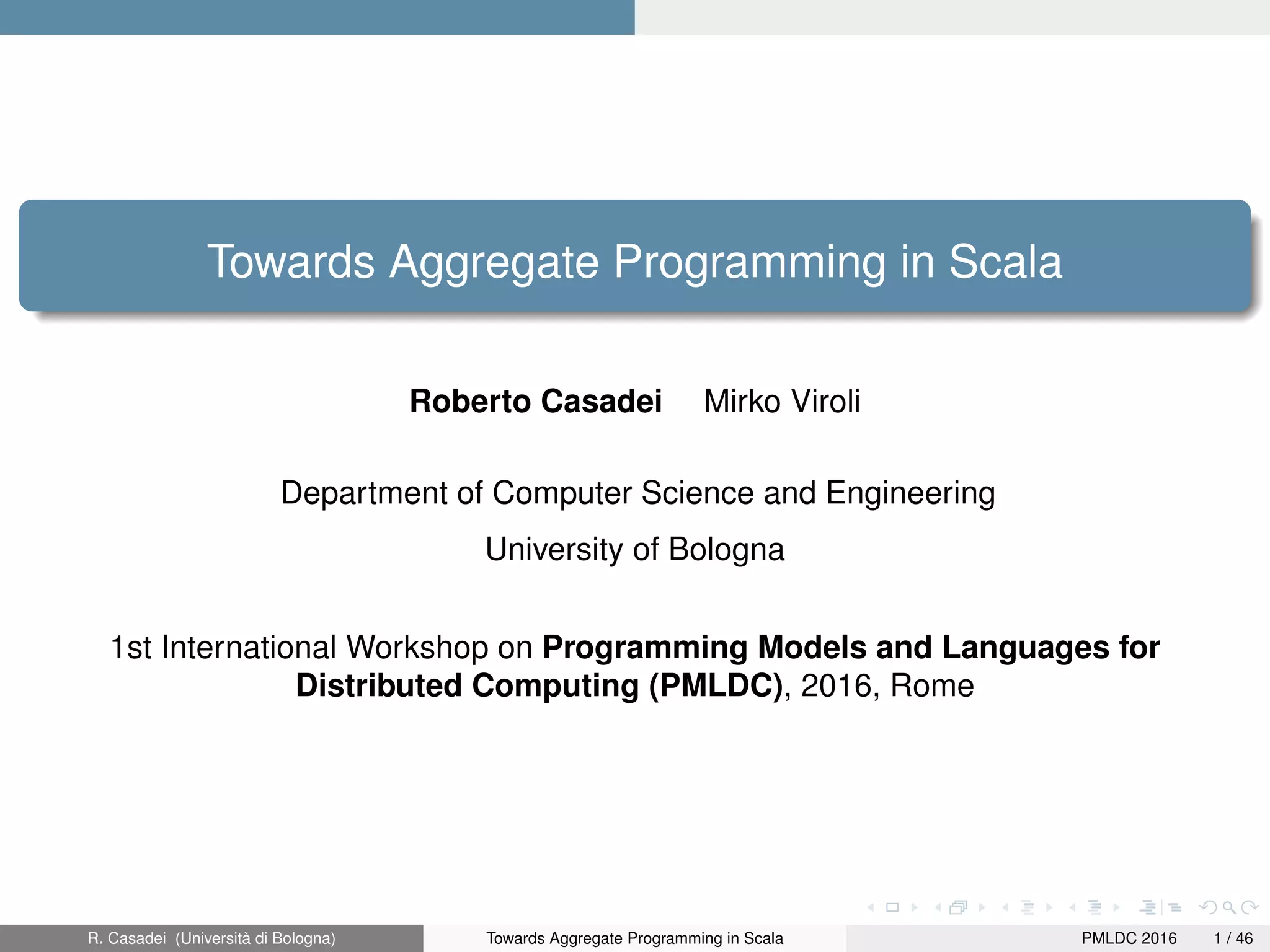
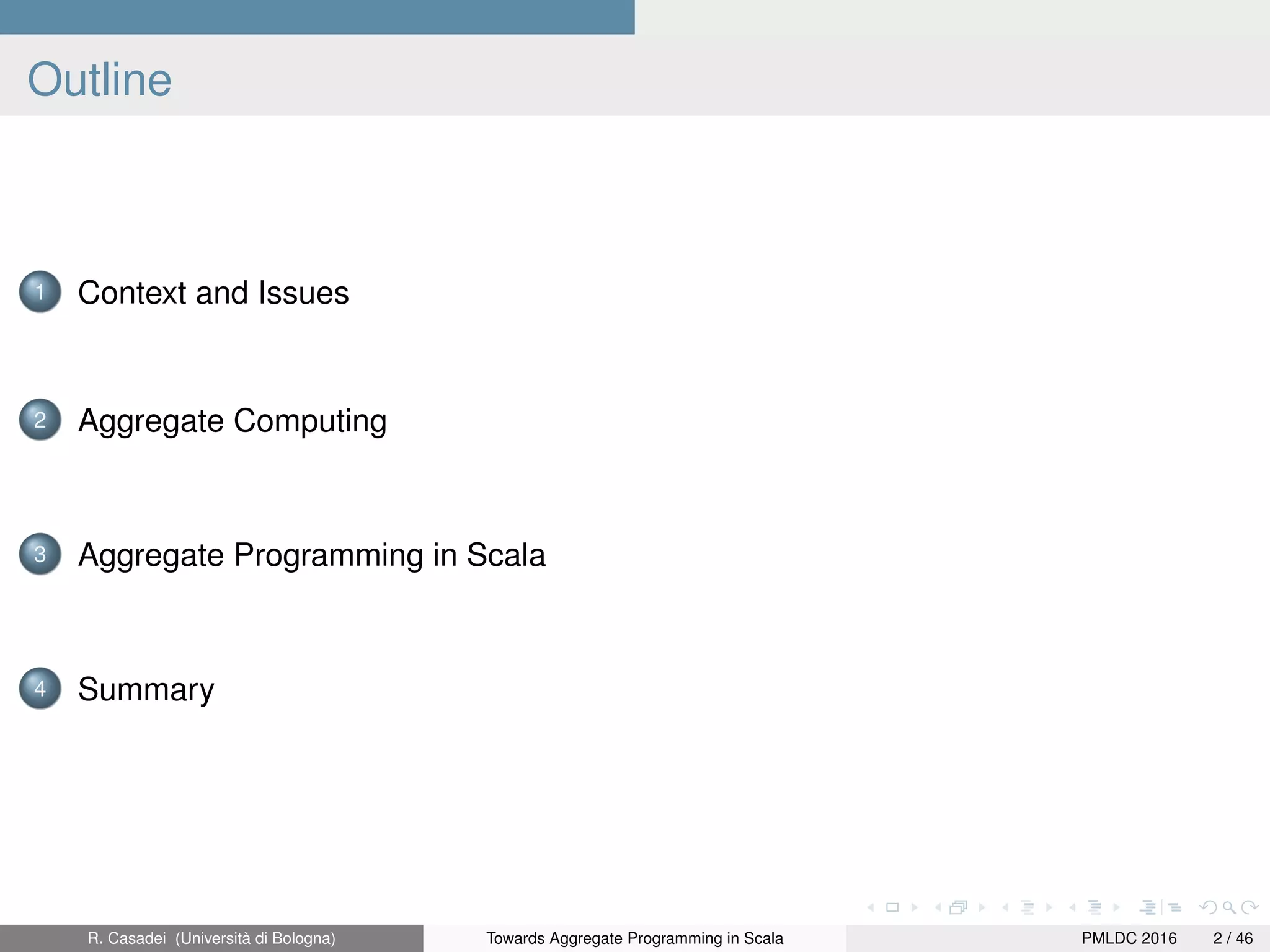
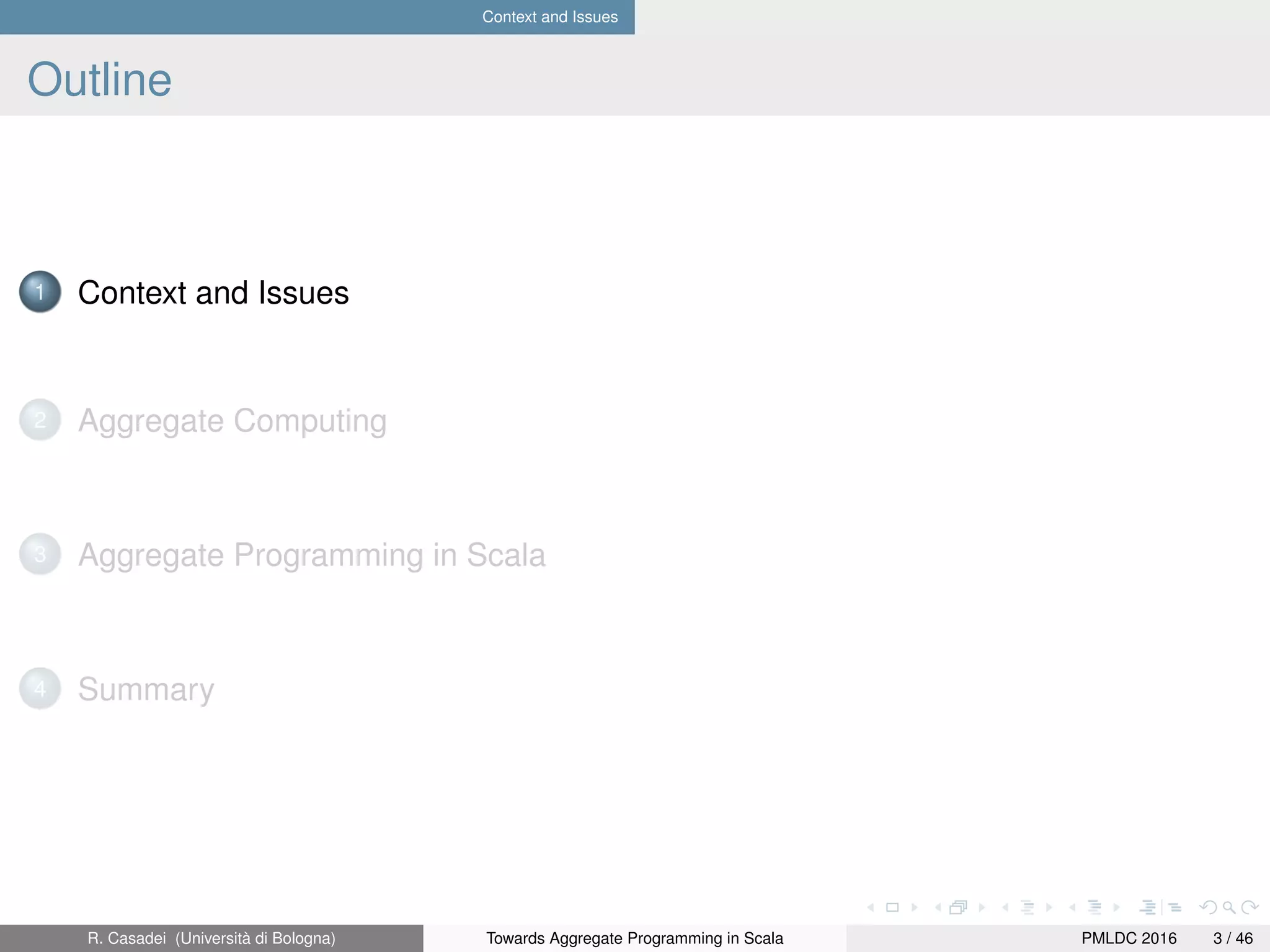
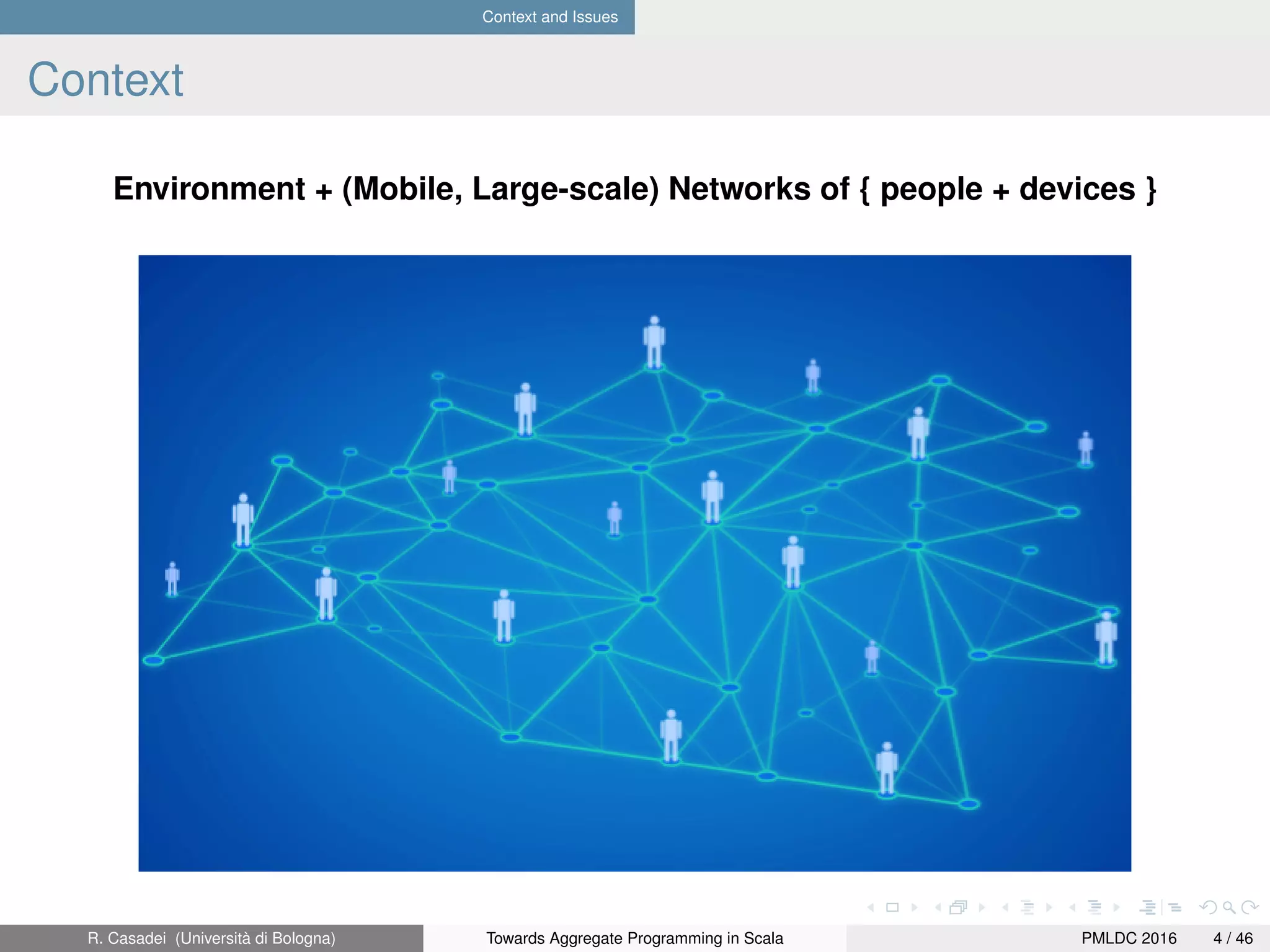
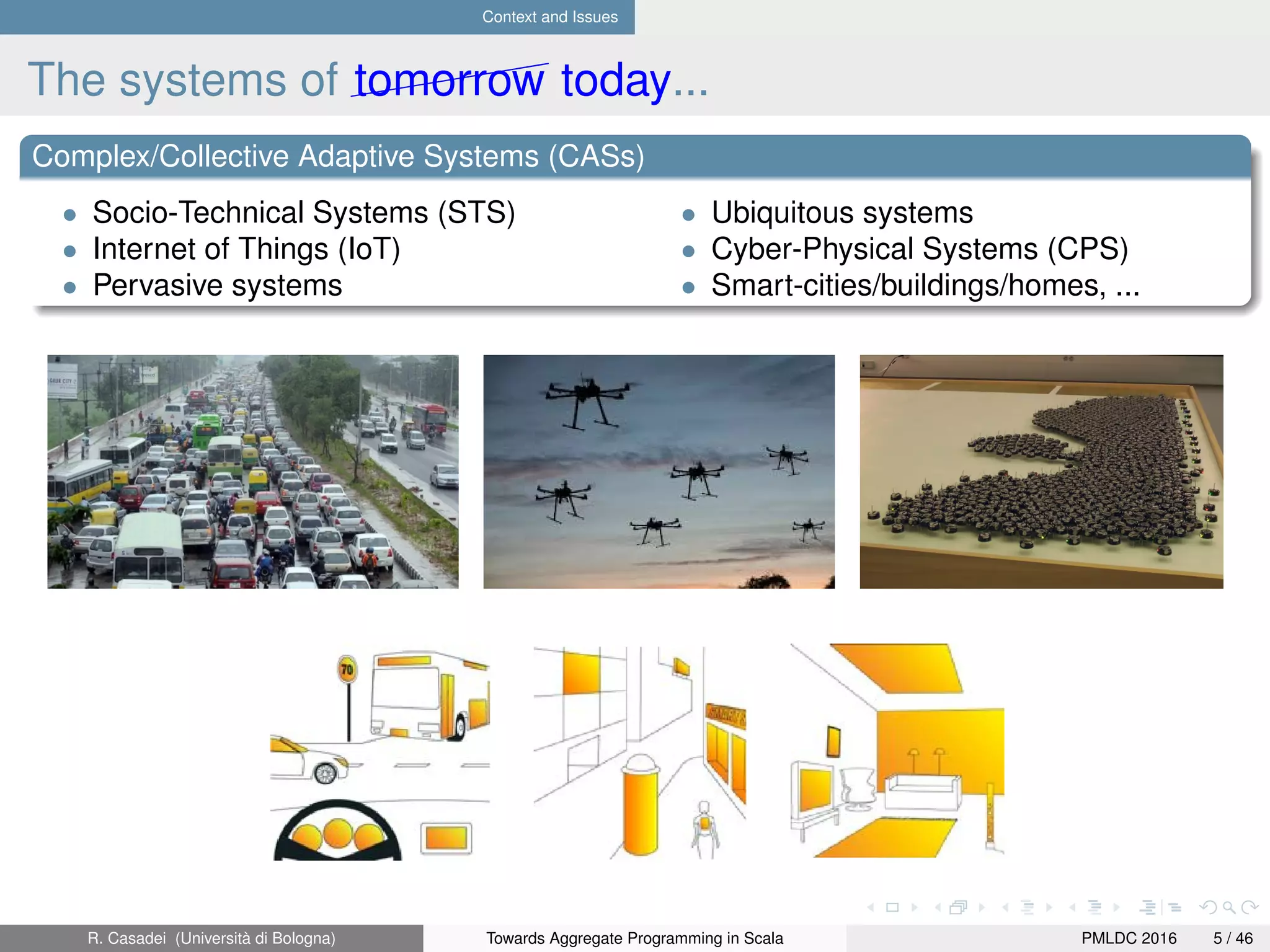
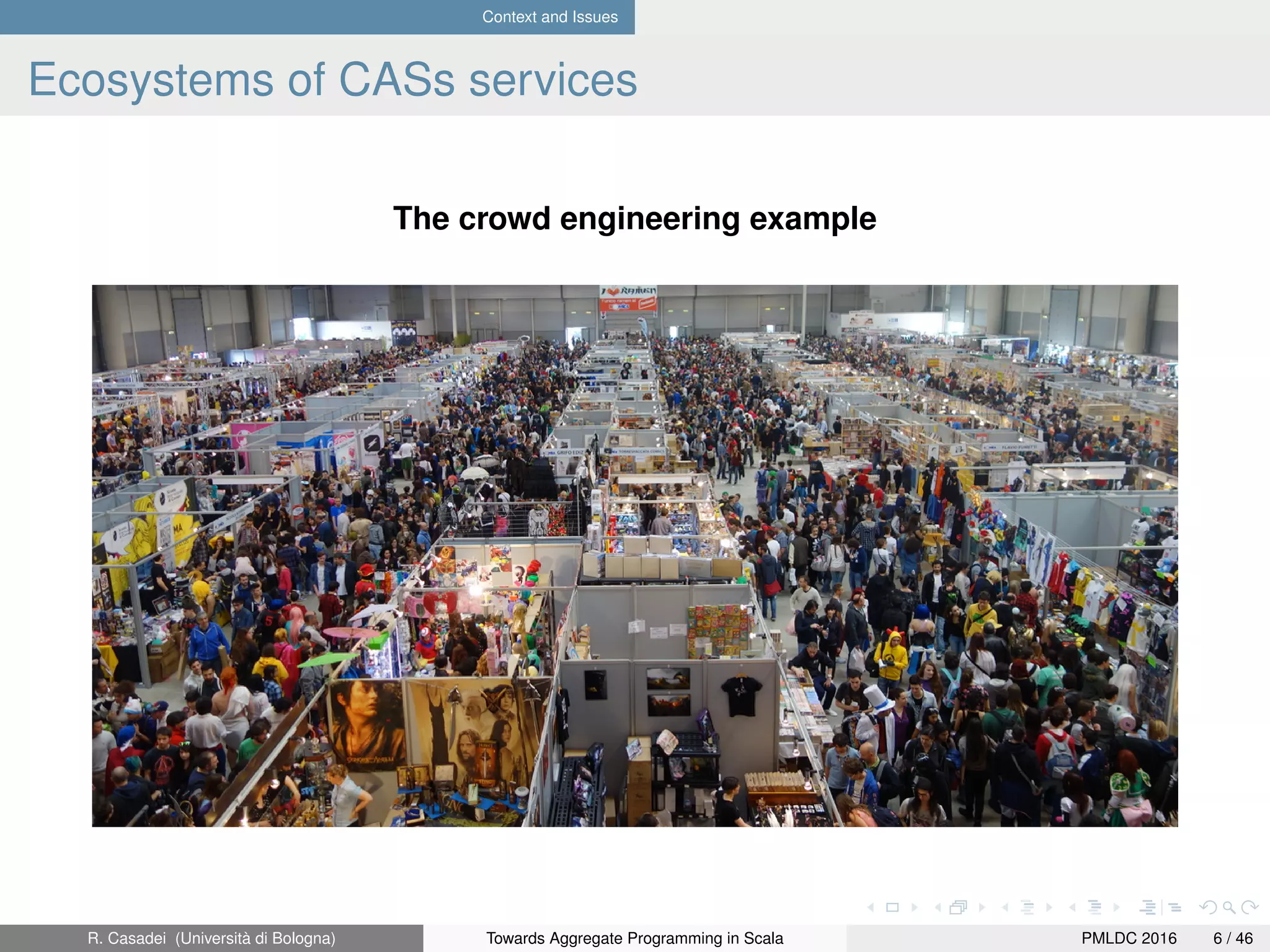
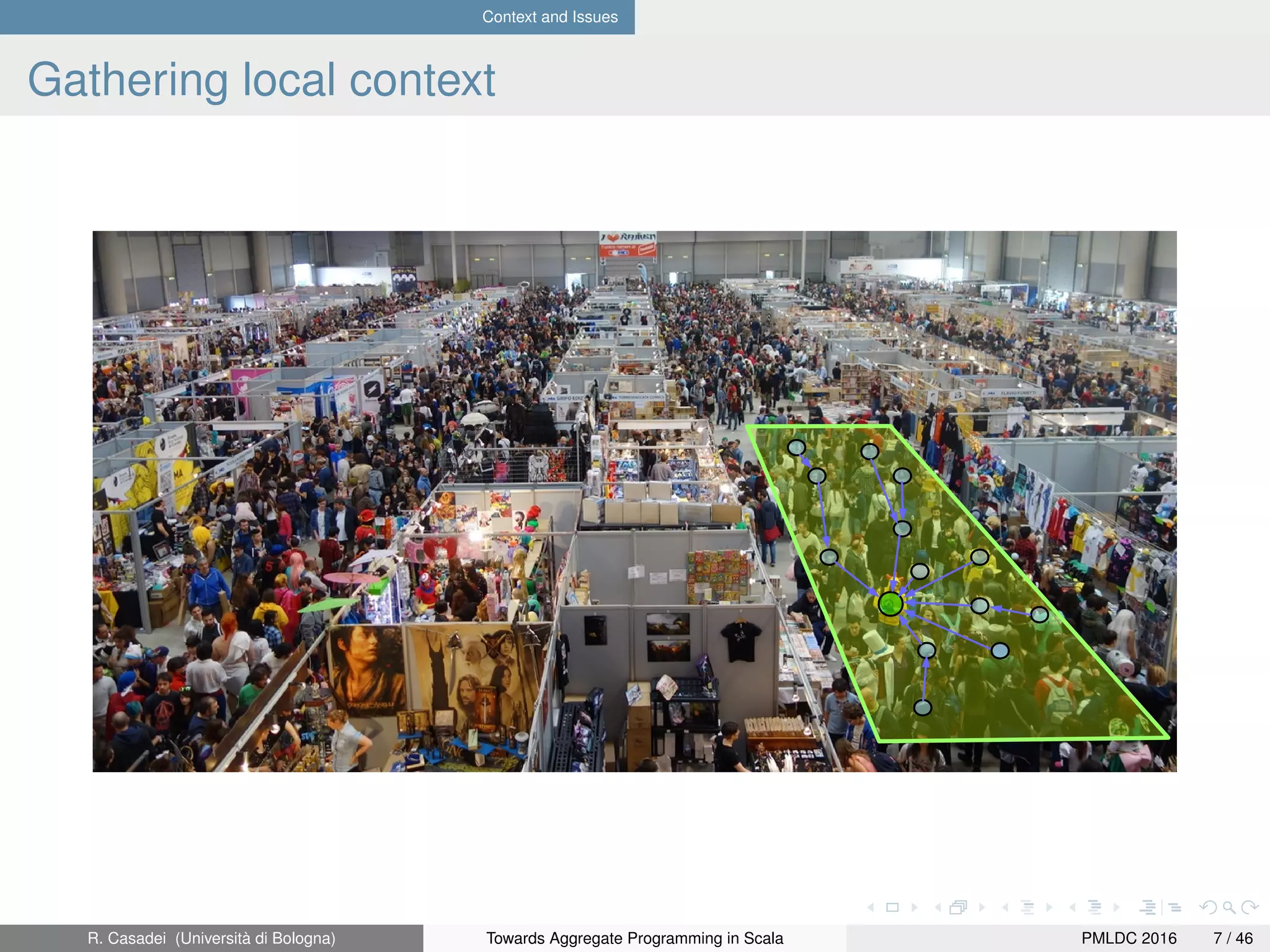
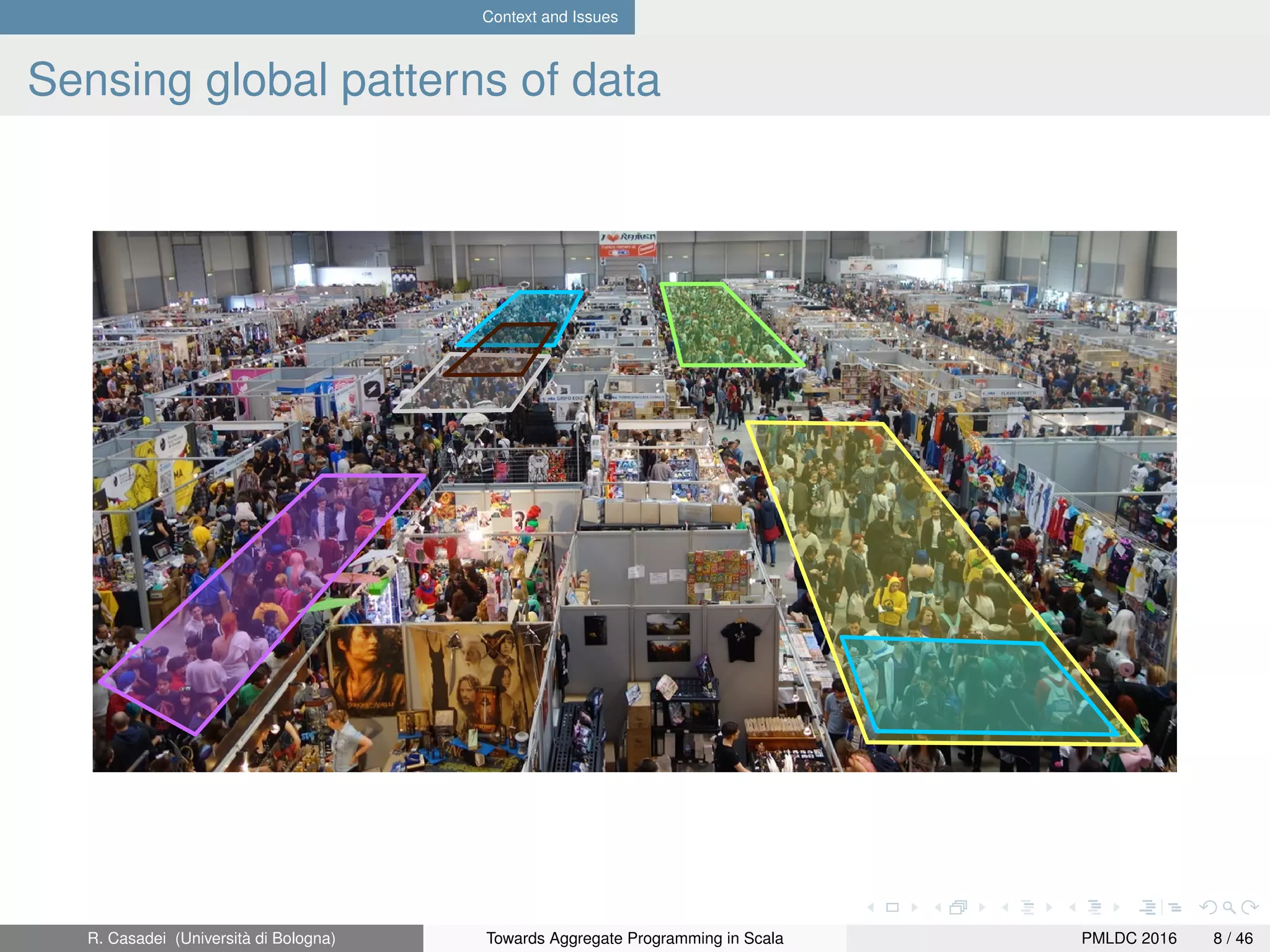
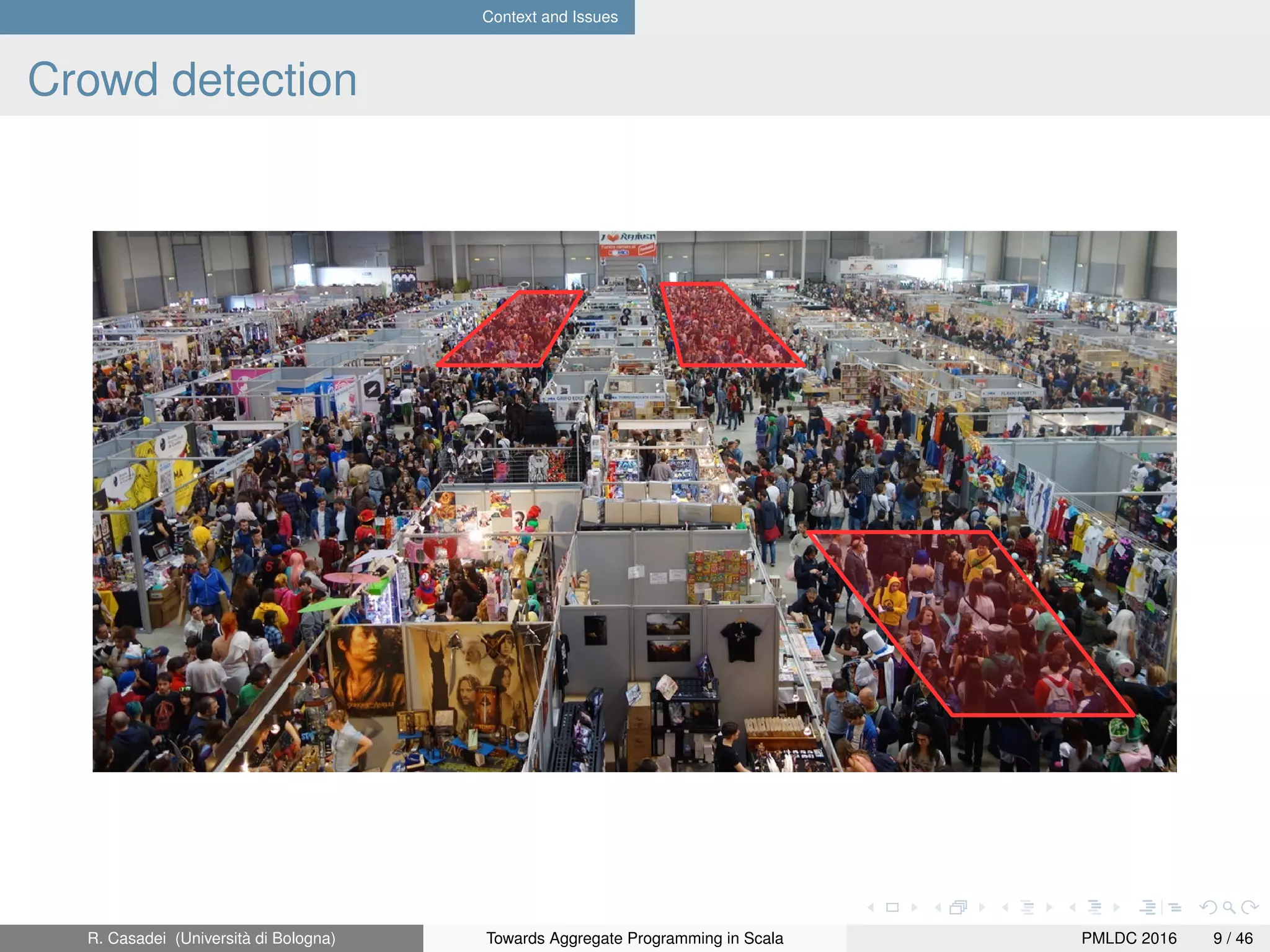
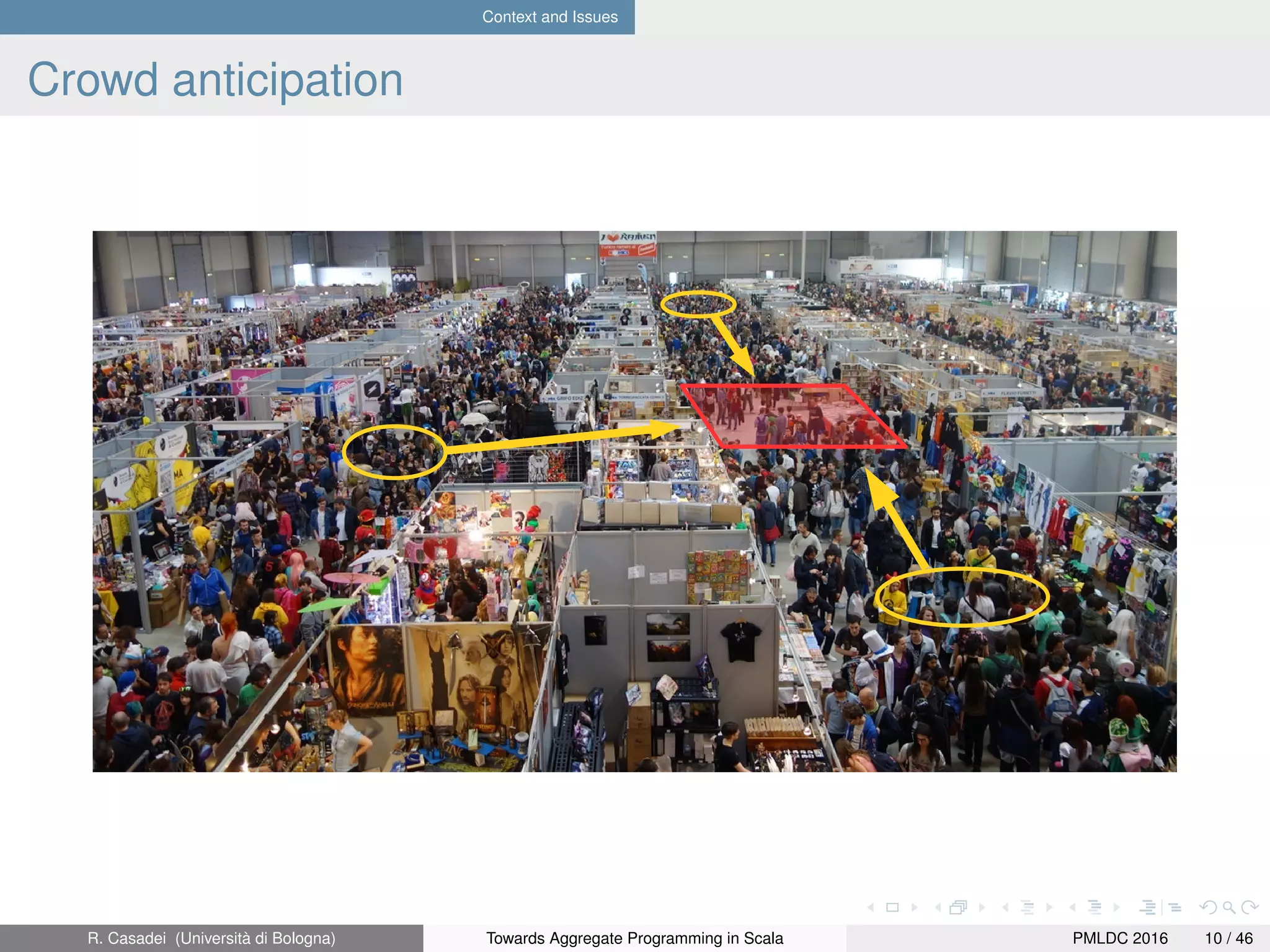
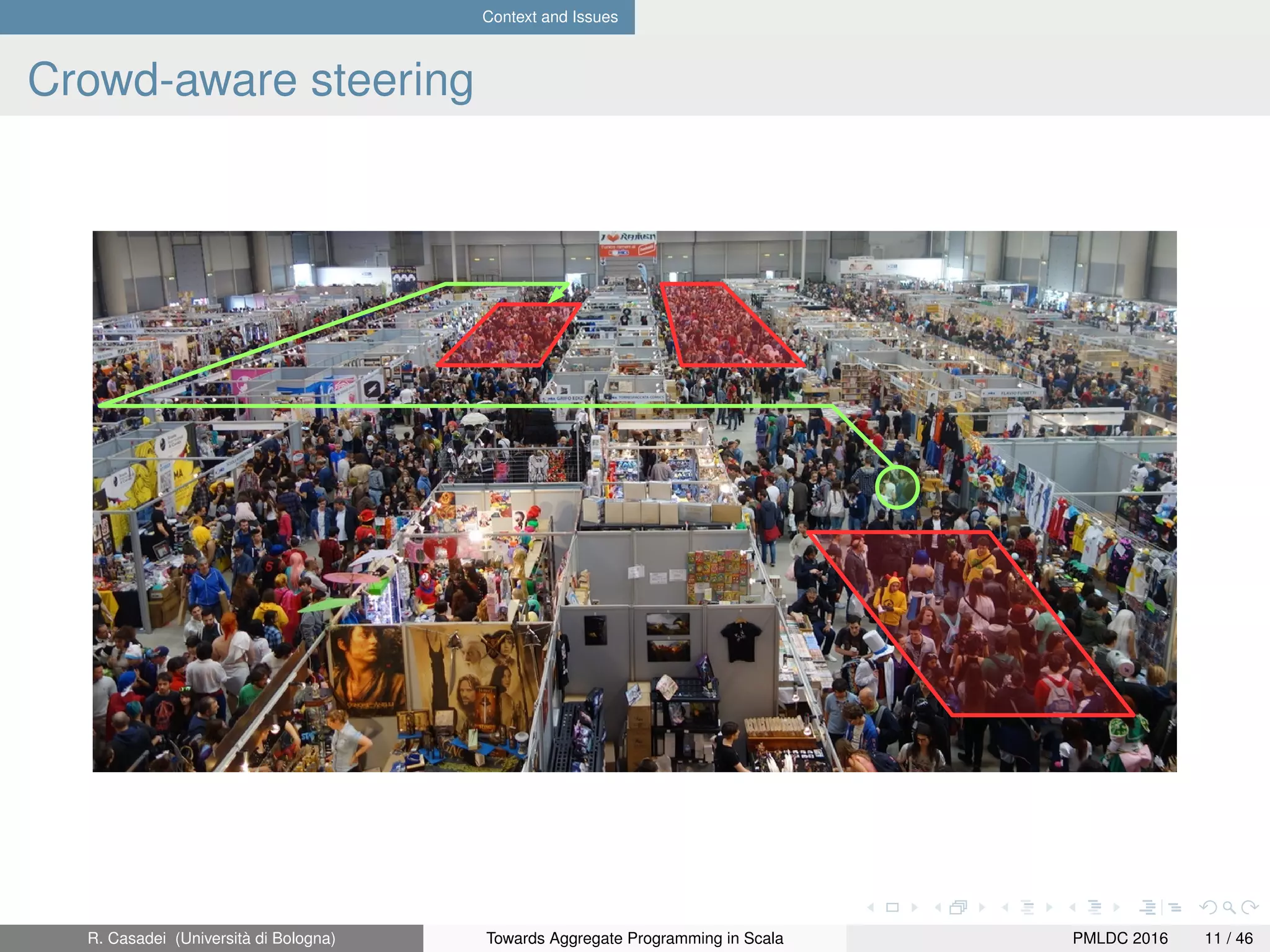
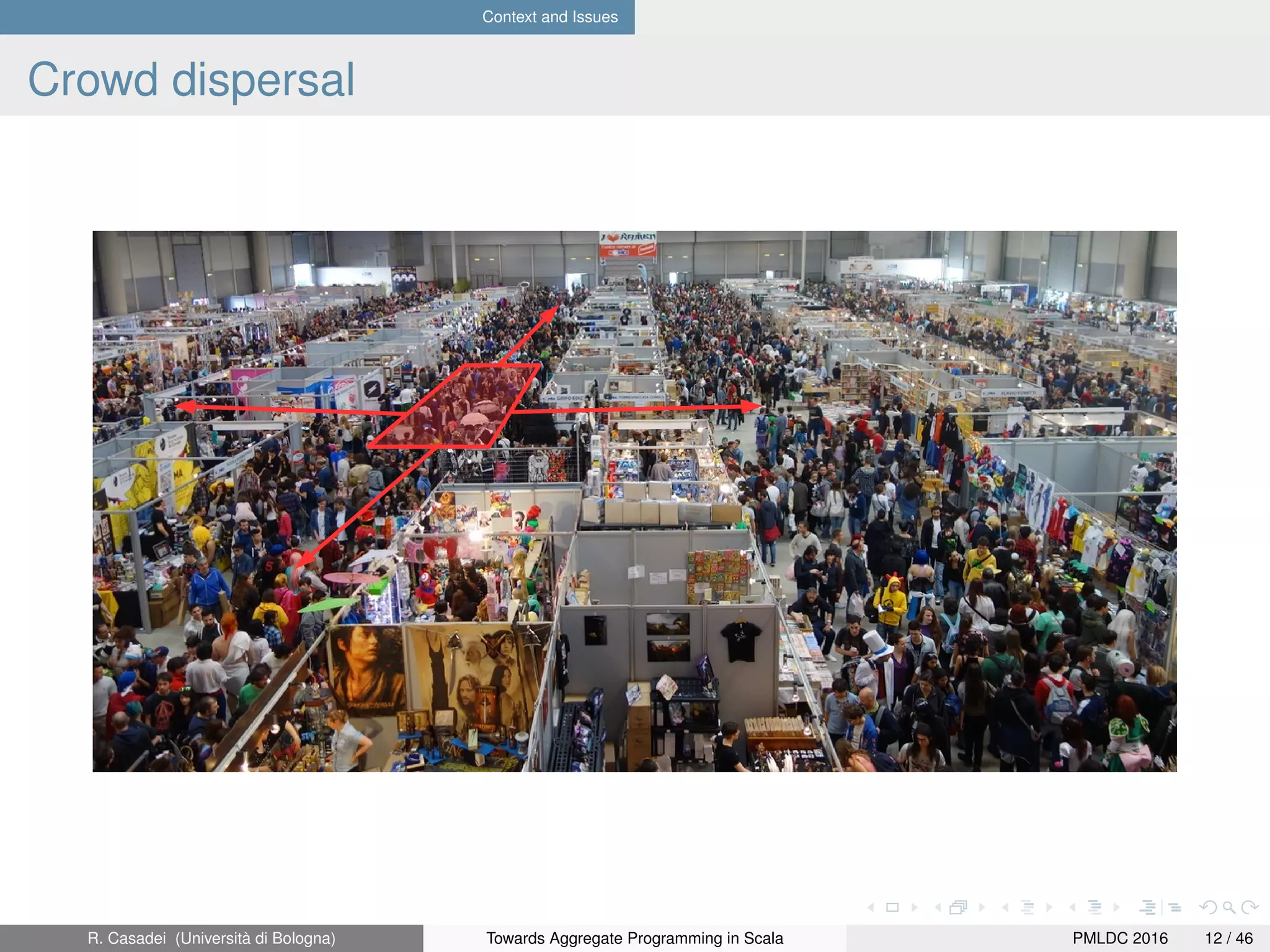
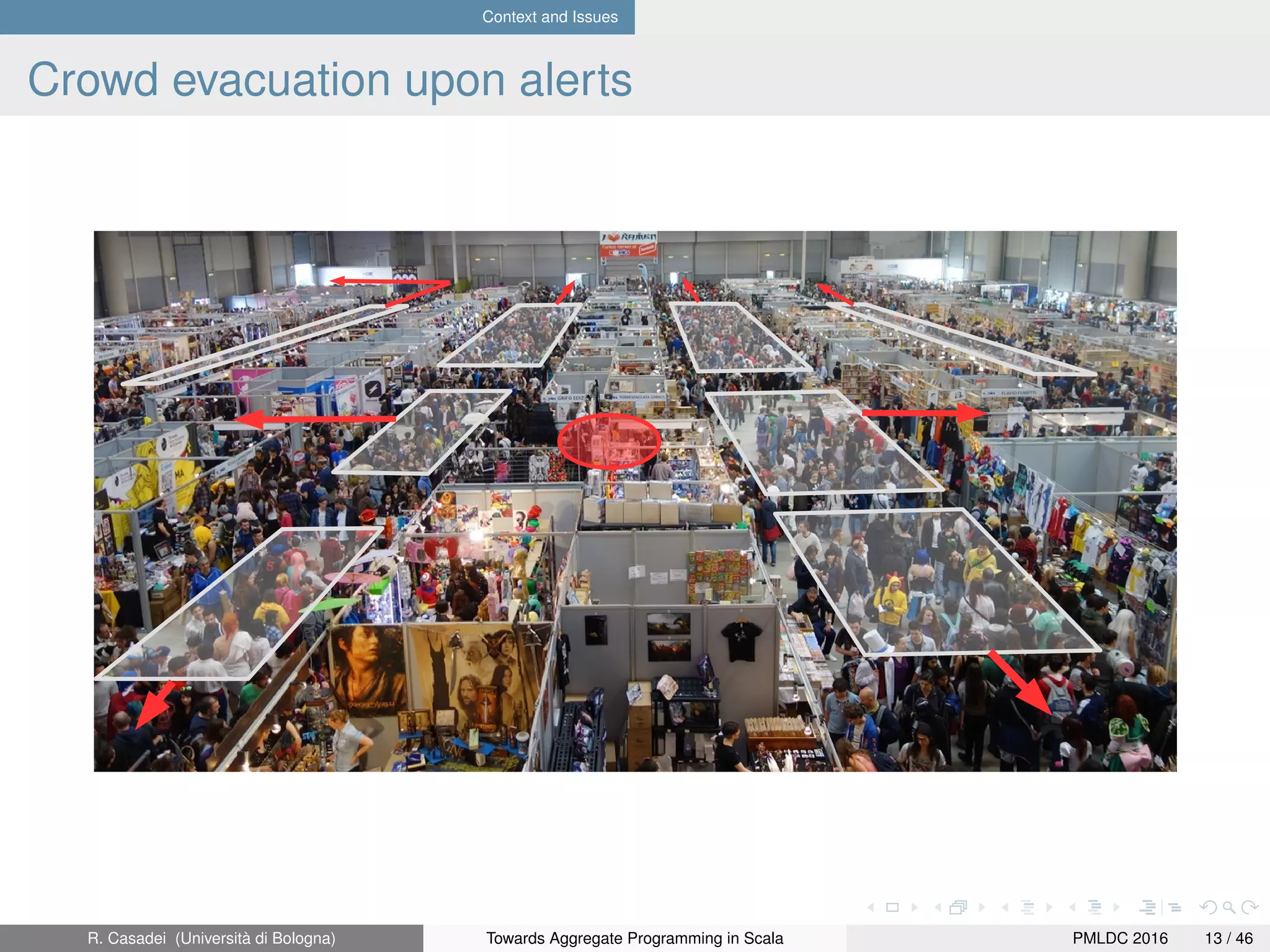
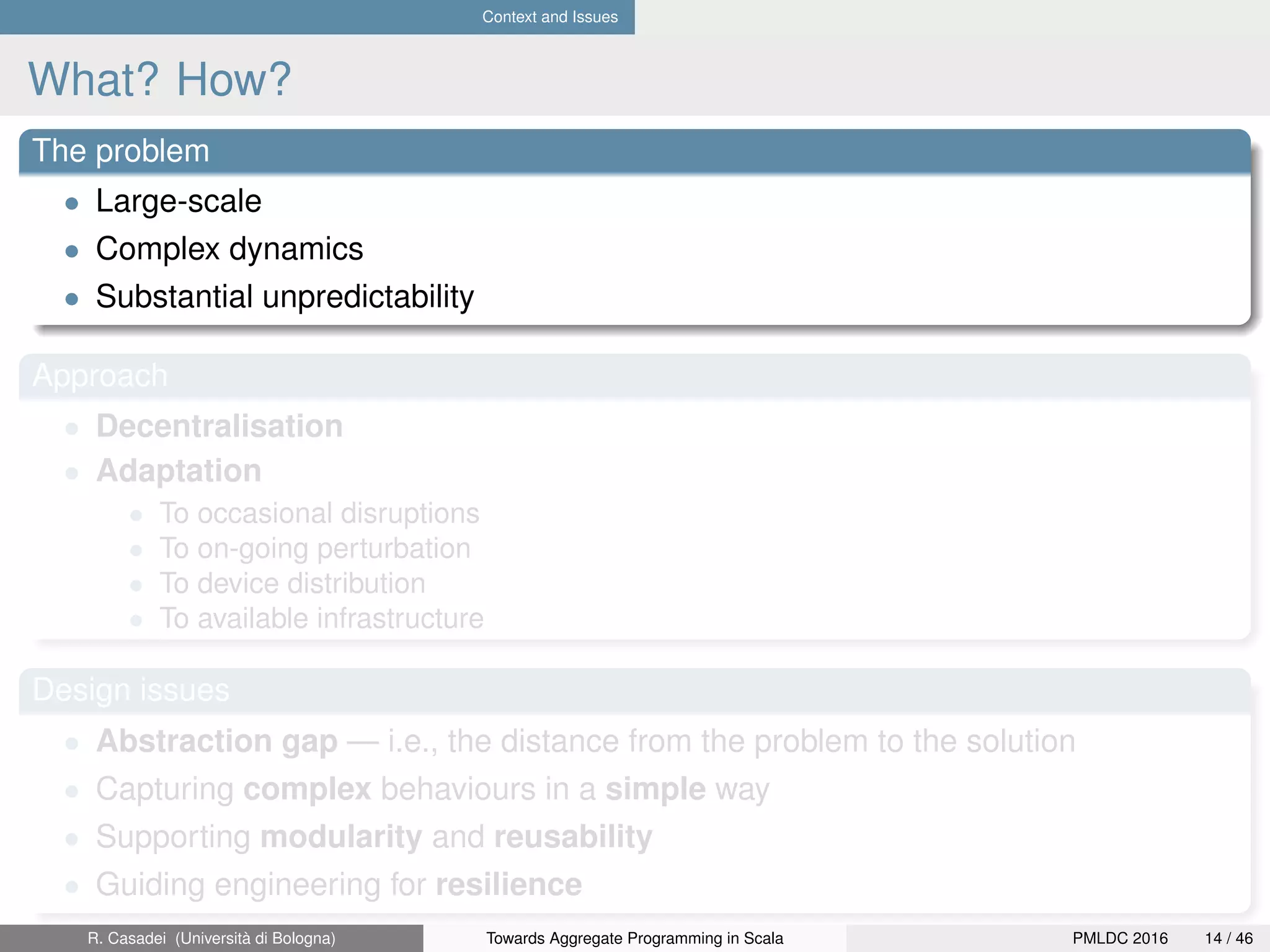
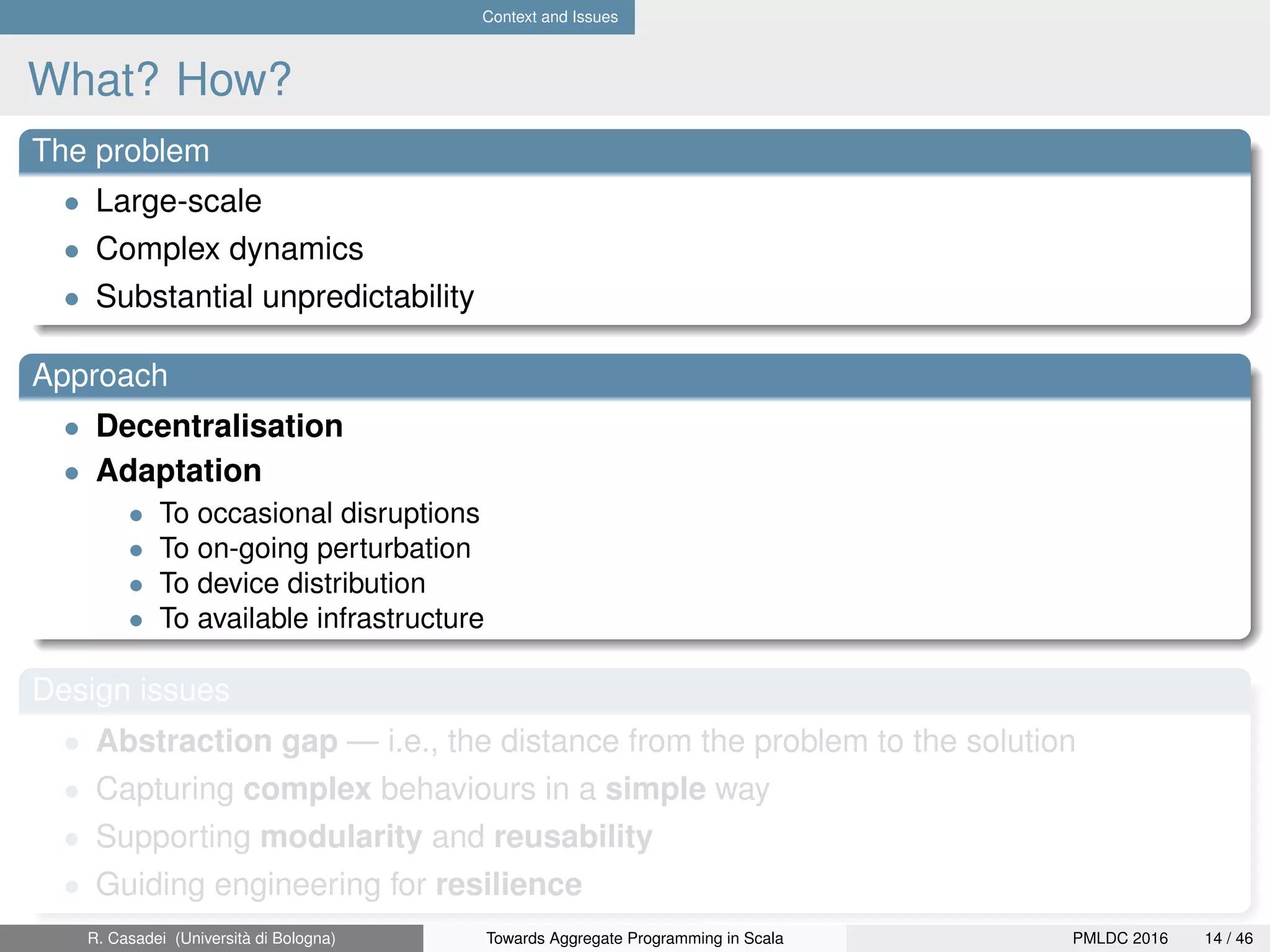
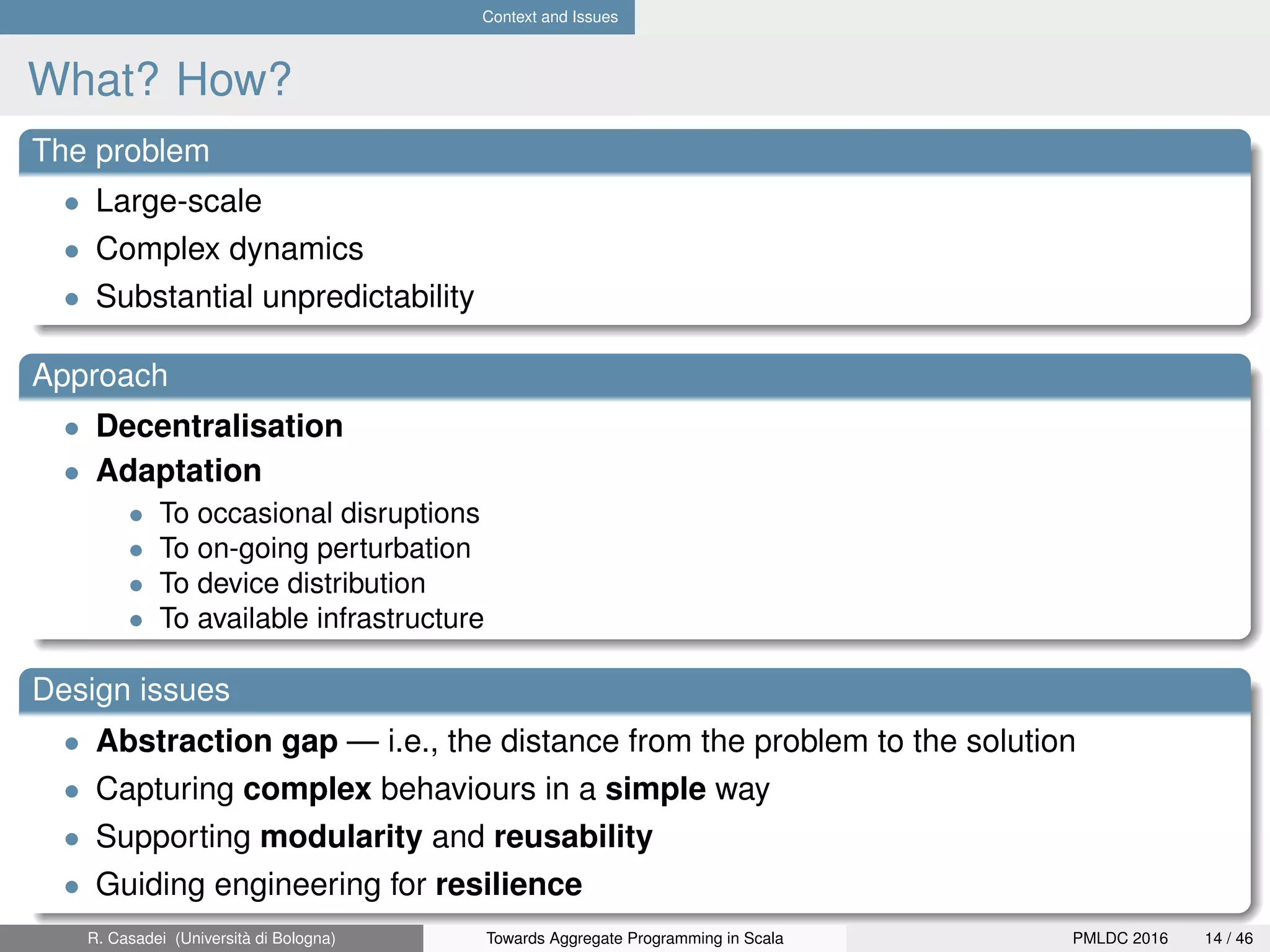
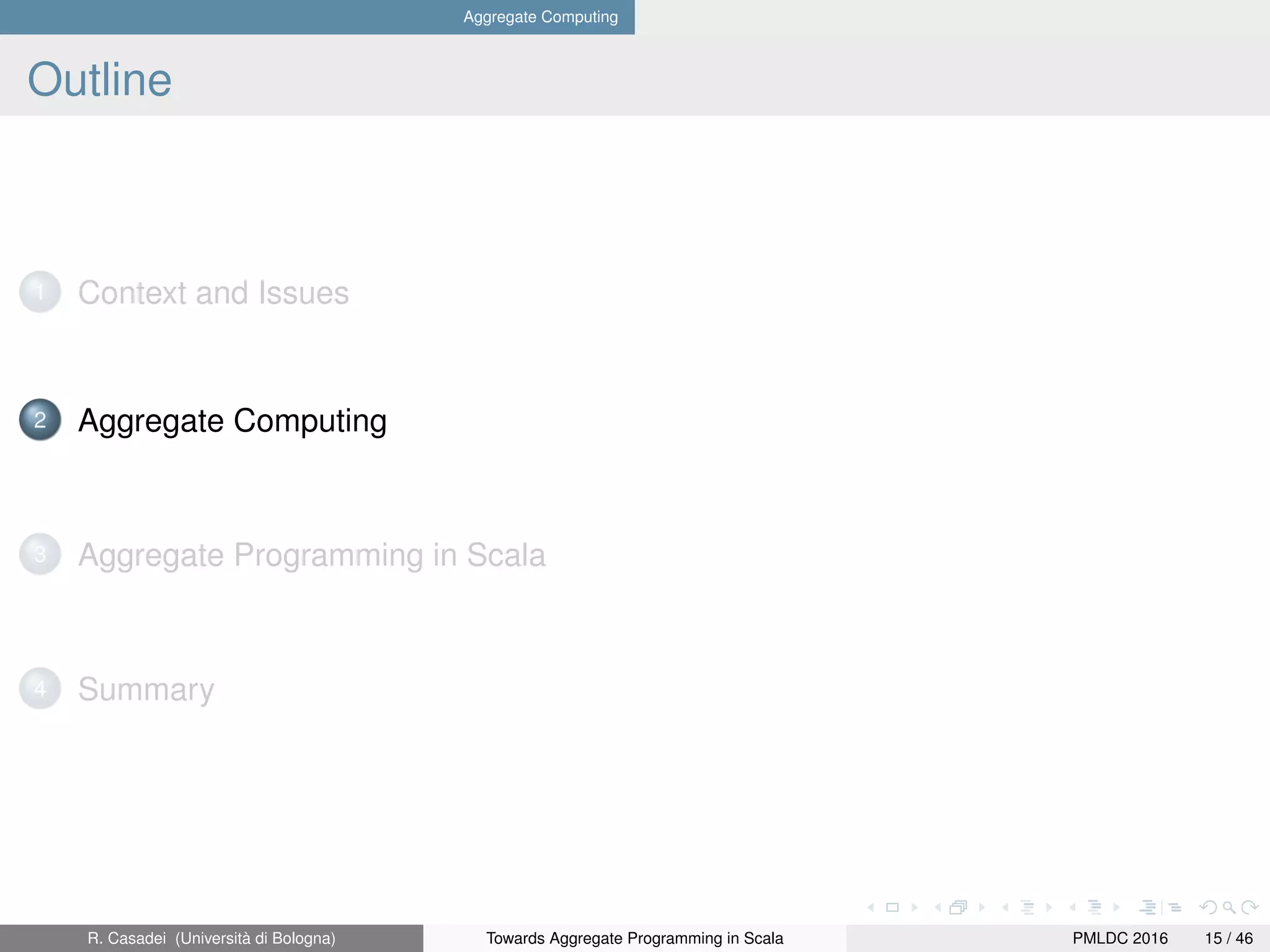
![Aggregate Computing The origins: self-organisation patterns [FMSM+ 13] R. Casadei (Università di Bologna) Towards Aggregate Programming in Scala PMLDC 2016 16 / 46](https://image.slidesharecdn.com/presentation-161022140524/75/Towards-Aggregate-Programming-in-Scala-18-2048.jpg)
![Aggregate Computing The origins: space-time programming [BV15] Space-oriented computation – Thematic areas (a) Intensive computing (b) Computation embedded in space (c) Space computation Decentralised spatial computing Computing “somewhere” [Duc13] • Location-related information • Spatial constraints to communication Space-time programming [BV15] • Computation expressed in terms of properties of the physical time and space in which it occurs • Spatial abstractions R. Casadei (Università di Bologna) Towards Aggregate Programming in Scala PMLDC 2016 17 / 46](https://image.slidesharecdn.com/presentation-161022140524/75/Towards-Aggregate-Programming-in-Scala-19-2048.jpg)
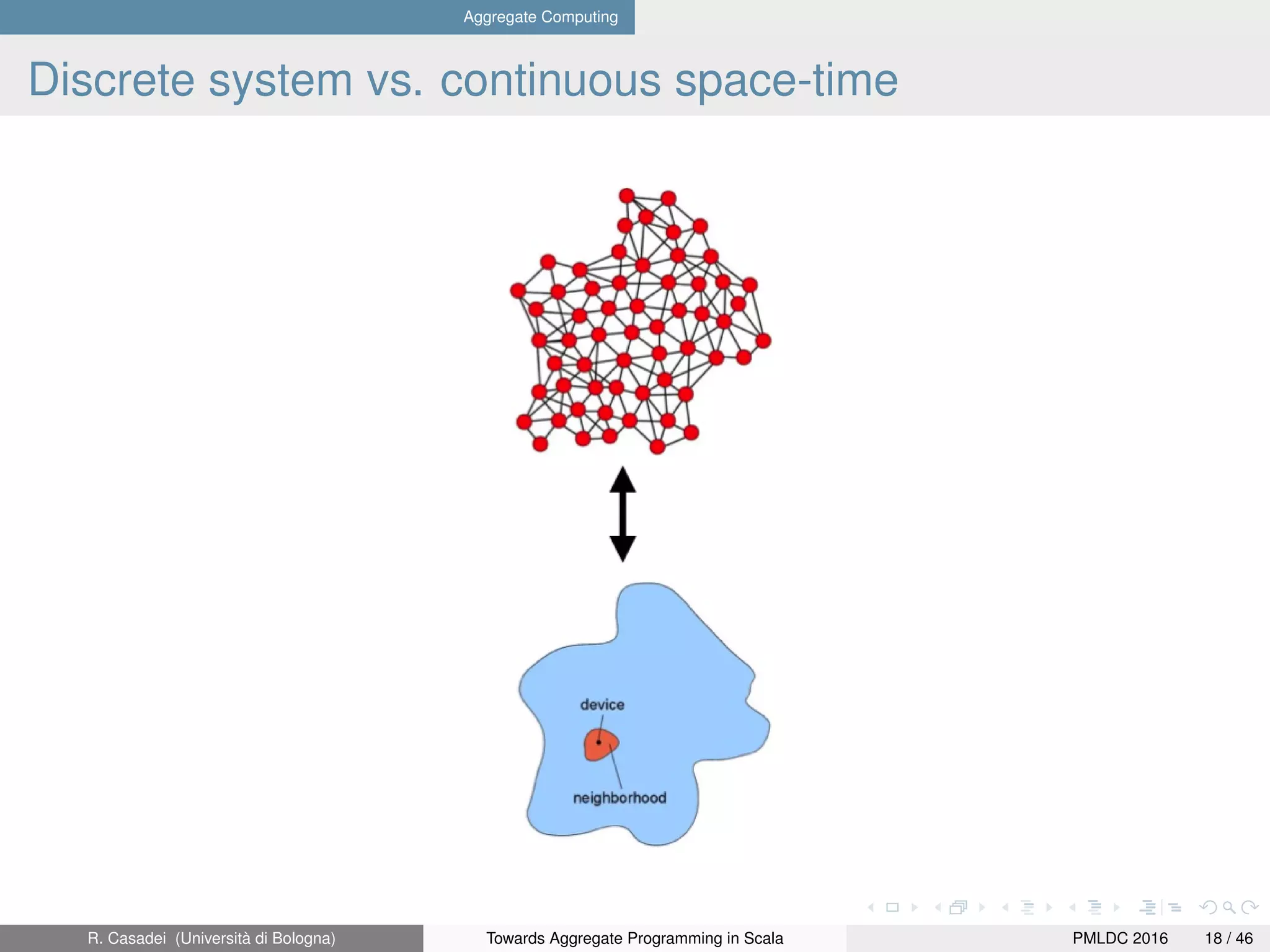
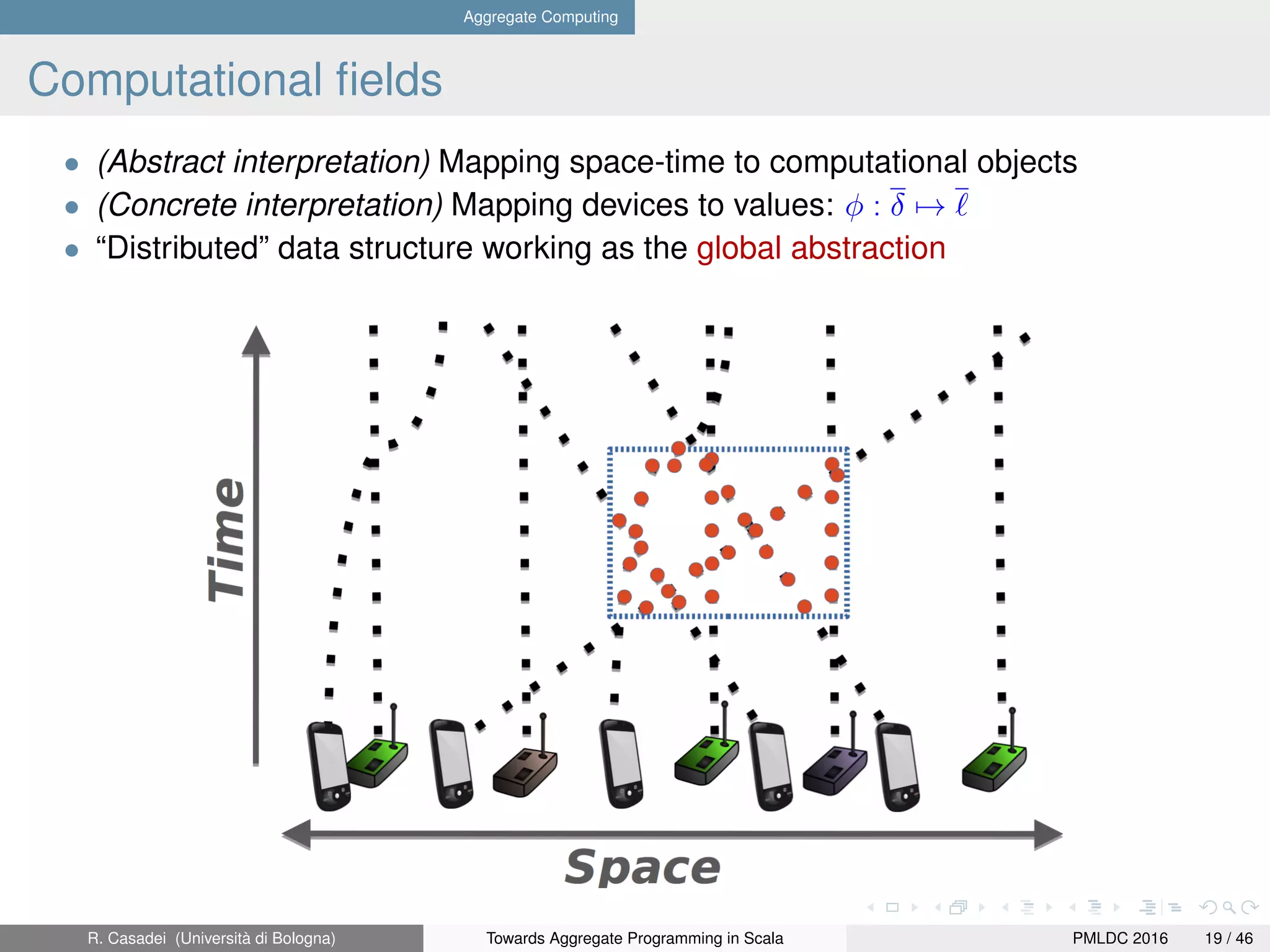
![Aggregate Computing The Computational Field Calculus I Field calculus A calculus of computational fields [DVB16] • Functional • Basis set of operators for field manipulation • Minimal expressive model ≈ Space-time universal Higher-Order Field Calculus (HOFC) [DVPB15] • First-class distributed functions • Code mobility R. Casadei (Università di Bologna) Towards Aggregate Programming in Scala PMLDC 2016 20 / 46](https://image.slidesharecdn.com/presentation-161022140524/75/Towards-Aggregate-Programming-in-Scala-22-2048.jpg)
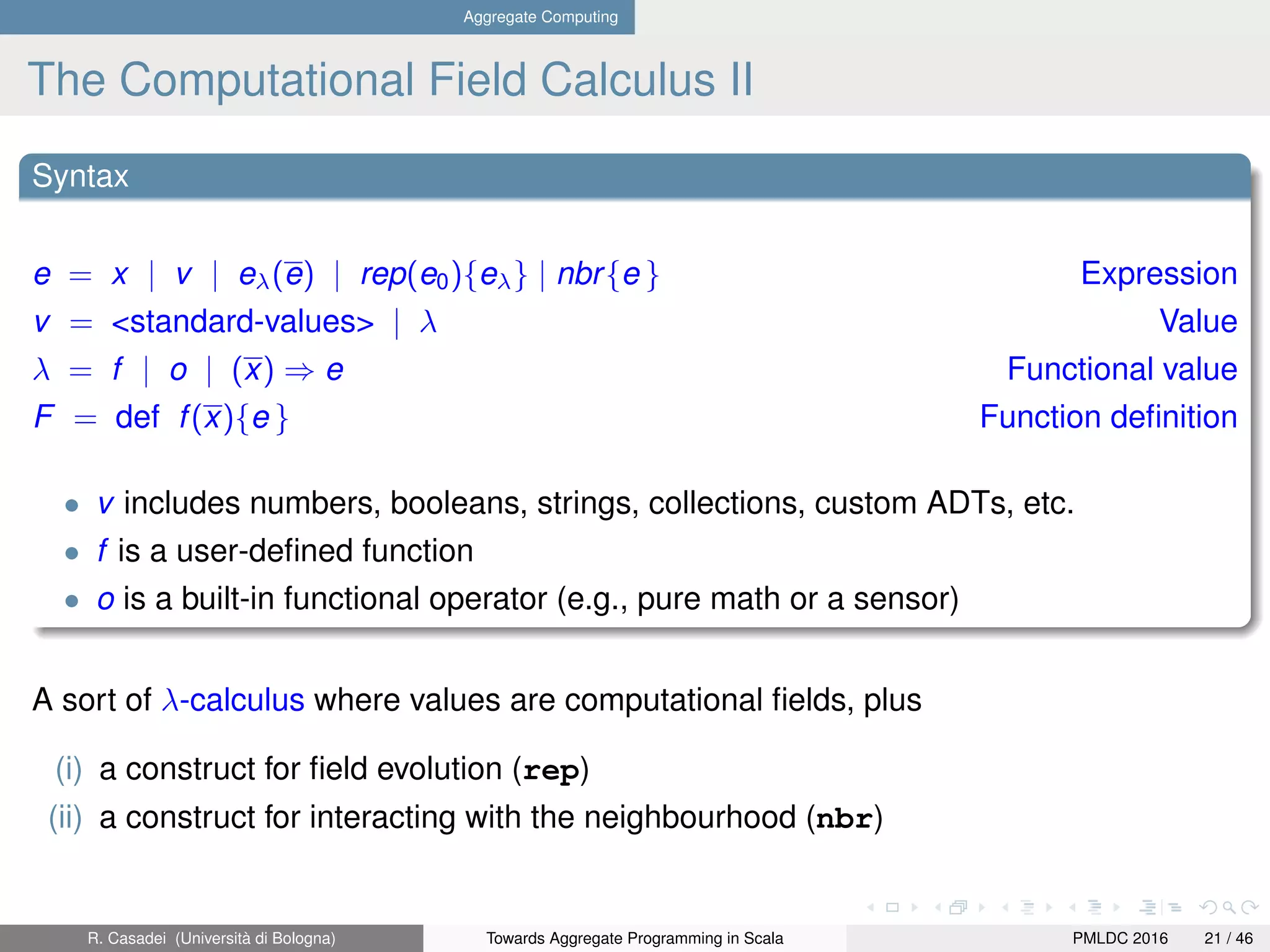
![Aggregate Computing The Computational Field Calculus III Global-level semantics, intuitively 0 (x)=>x+1 true t<0,1> ()0 1 + - 1 -1 ef(0,1) ef rep 0 (x)=>x+1 t v0 t v1 .. rep(0){(x)=>x+1} nbr de nbr{e} φd=[d1→v1,..,dn→vn] R. Casadei (Università di Bologna) Towards Aggregate Programming in Scala PMLDC 2016 22 / 46](https://image.slidesharecdn.com/presentation-161022140524/75/Towards-Aggregate-Programming-in-Scala-24-2048.jpg)
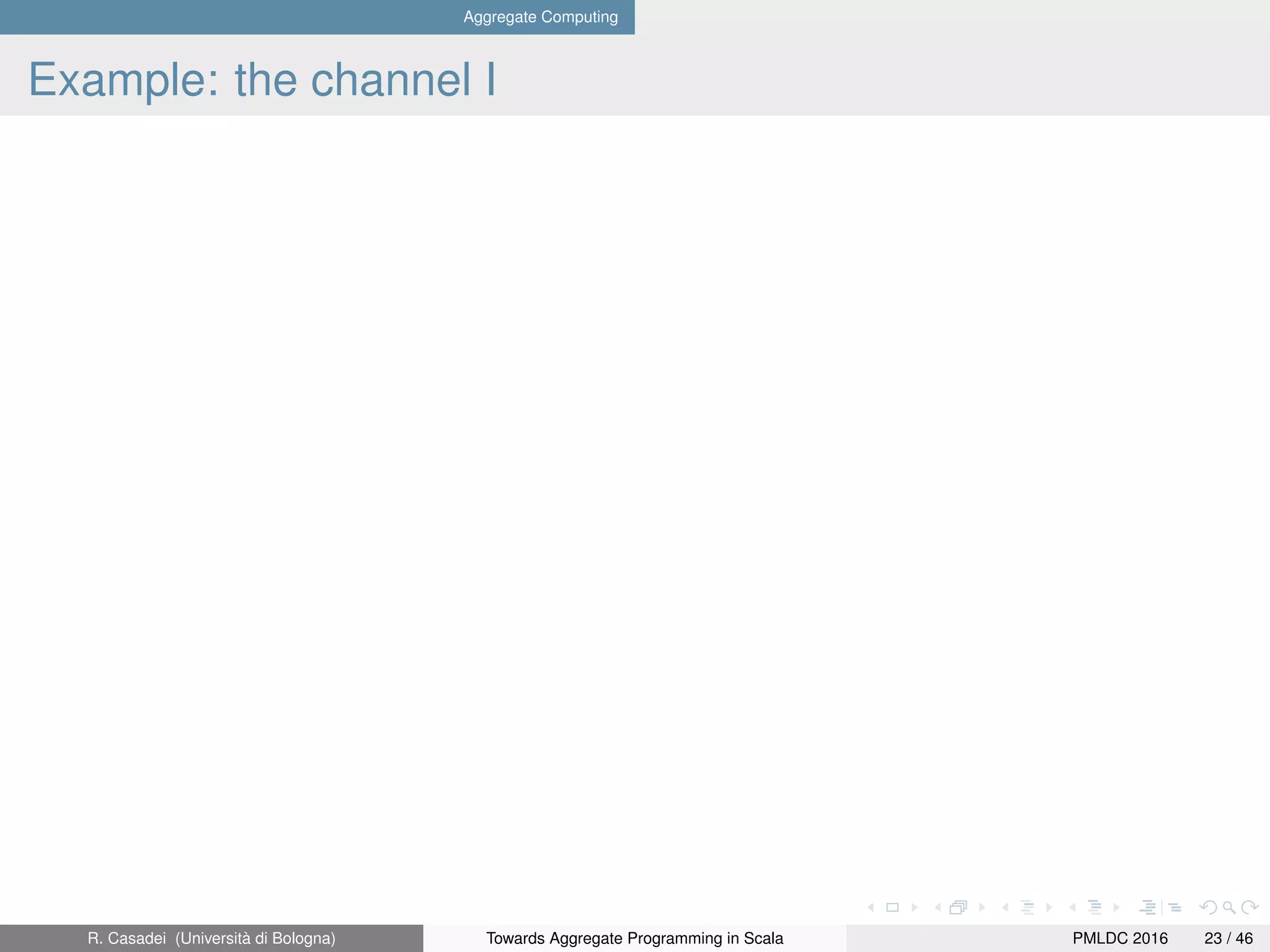
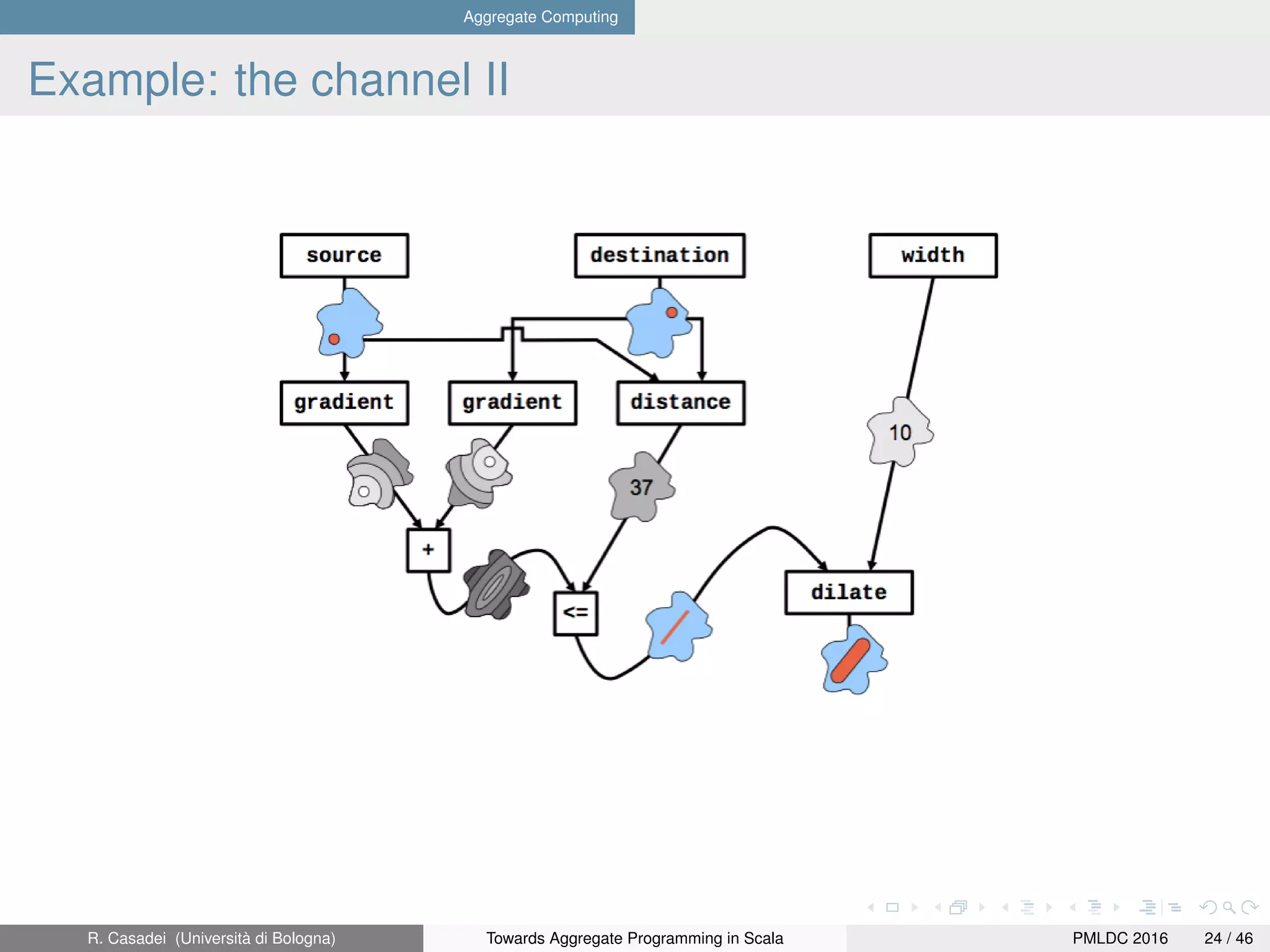
![Aggregate Computing Aggregate functions [DVPB15] Left: branch(c){ f(x) }{ g(x) } Right: (branch(c){ f }{ g })(x) R. Casadei (Università di Bologna) Towards Aggregate Programming in Scala PMLDC 2016 25 / 46](https://image.slidesharecdn.com/presentation-161022140524/75/Towards-Aggregate-Programming-in-Scala-27-2048.jpg)
![Aggregate Computing Aggregate programming [BPV15] Programming (collective adaptive) systems: viewpoints (a) Local viewpoint (device-centric view) (b) Global viewpoint (aggregate view) Aggregate programming: what Goal: programming the collective behaviour of aggregates Global-to-local mapping Aggregate programming: how Prominent approach founded on field calculus and self-org patterns Composable self-organisation • Self-stabilisation • Building blocks for resilient coordination R. Casadei (Università di Bologna) Towards Aggregate Programming in Scala PMLDC 2016 26 / 46](https://image.slidesharecdn.com/presentation-161022140524/75/Towards-Aggregate-Programming-in-Scala-28-2048.jpg)
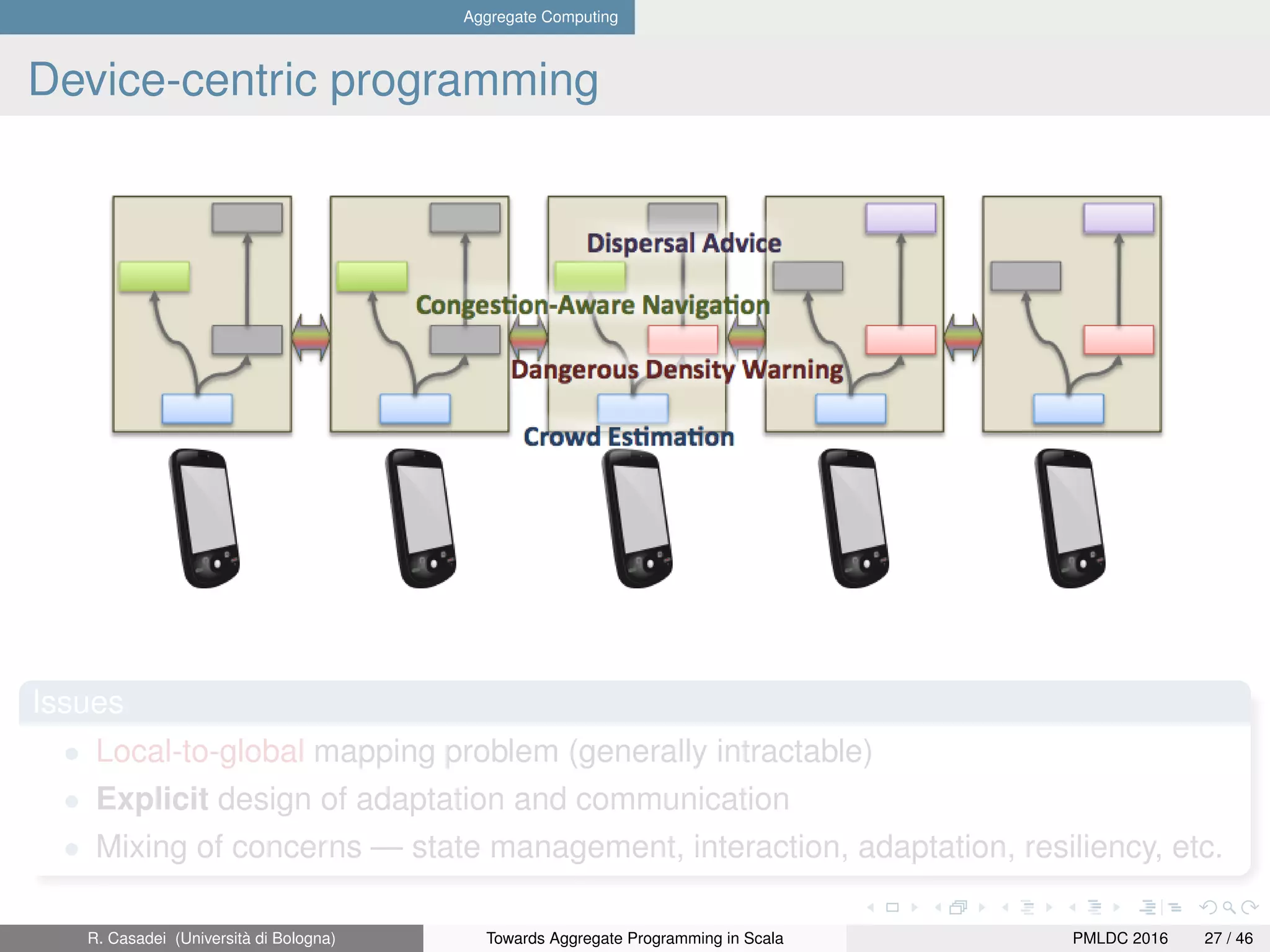
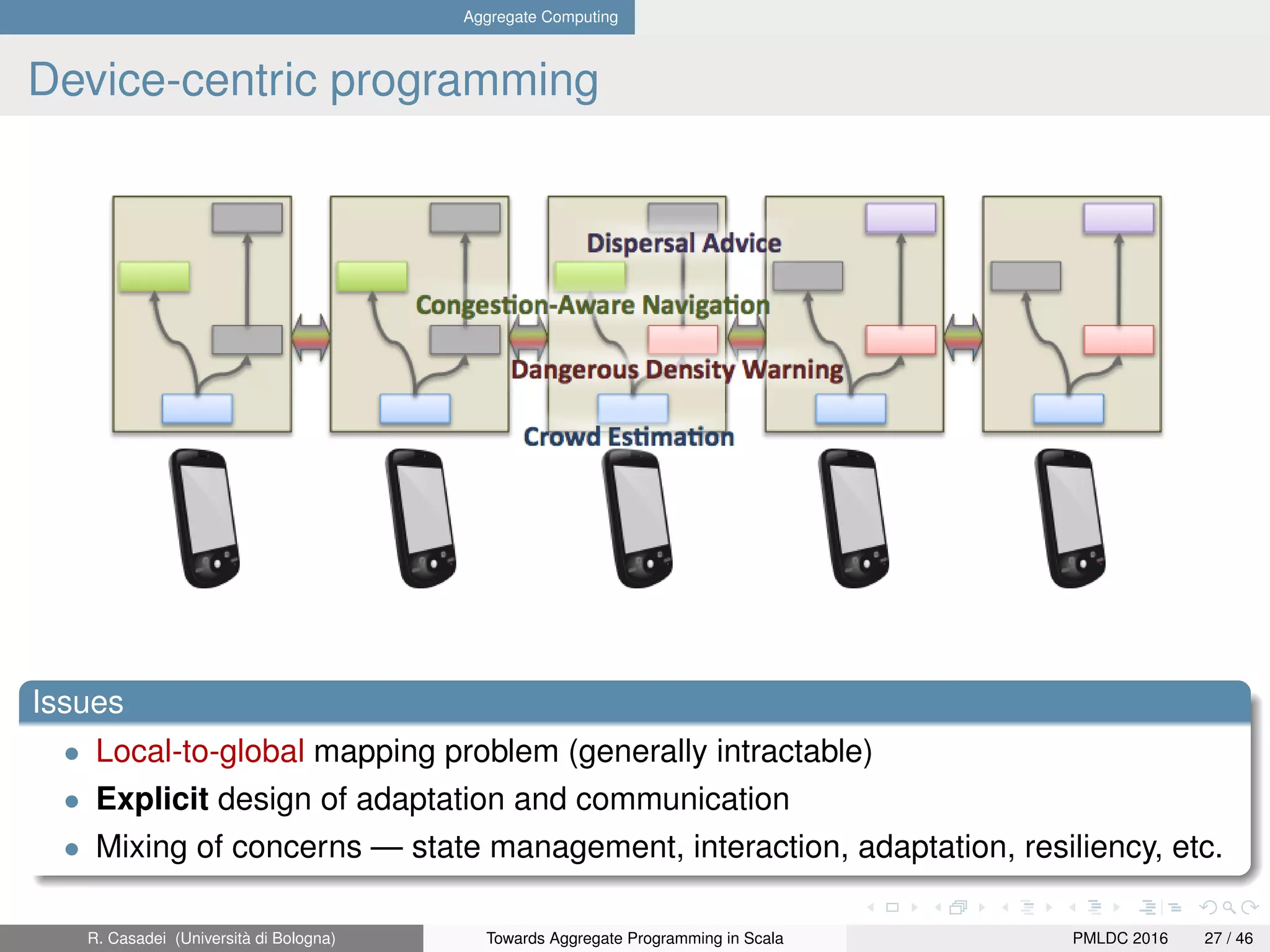
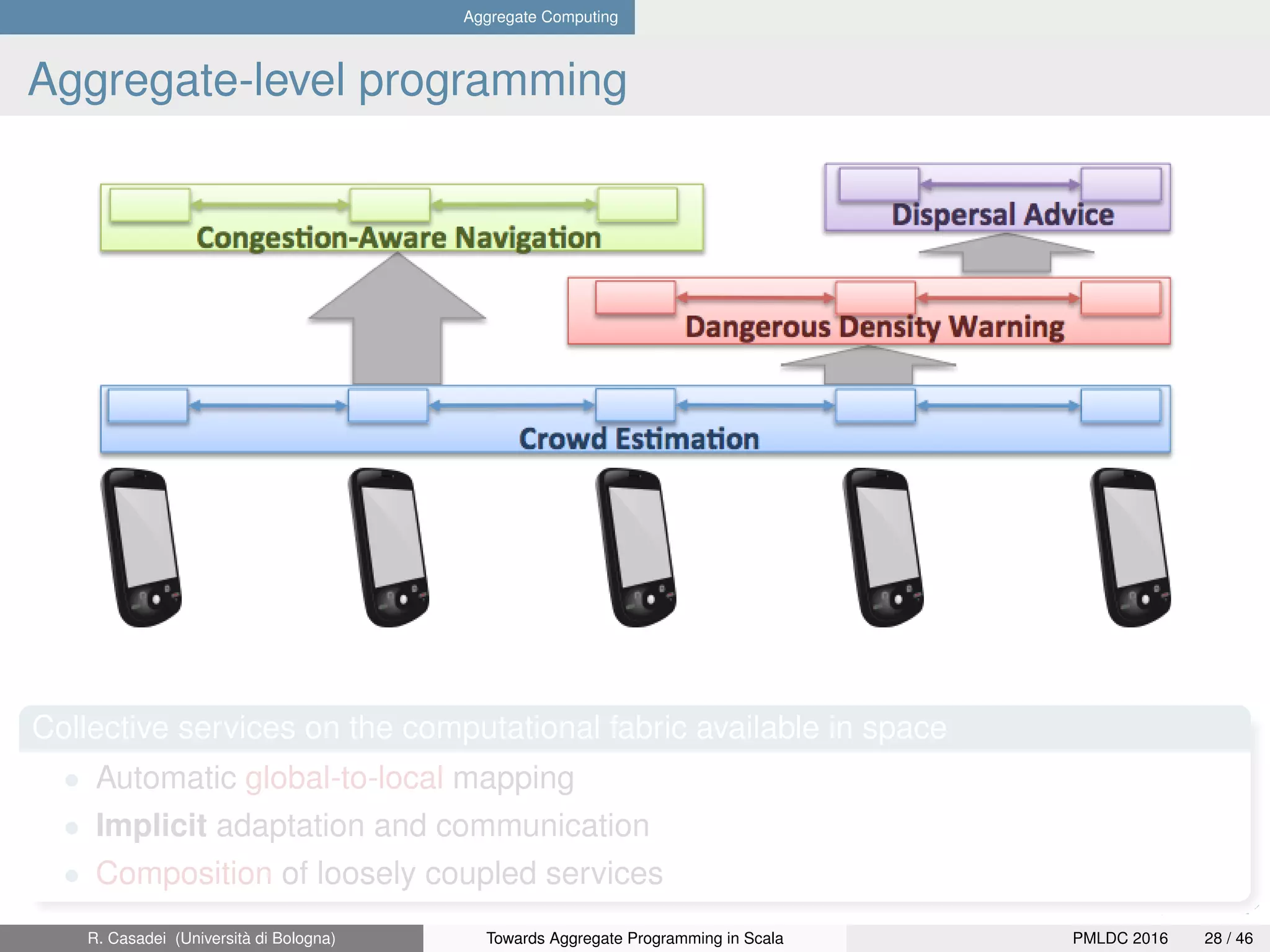
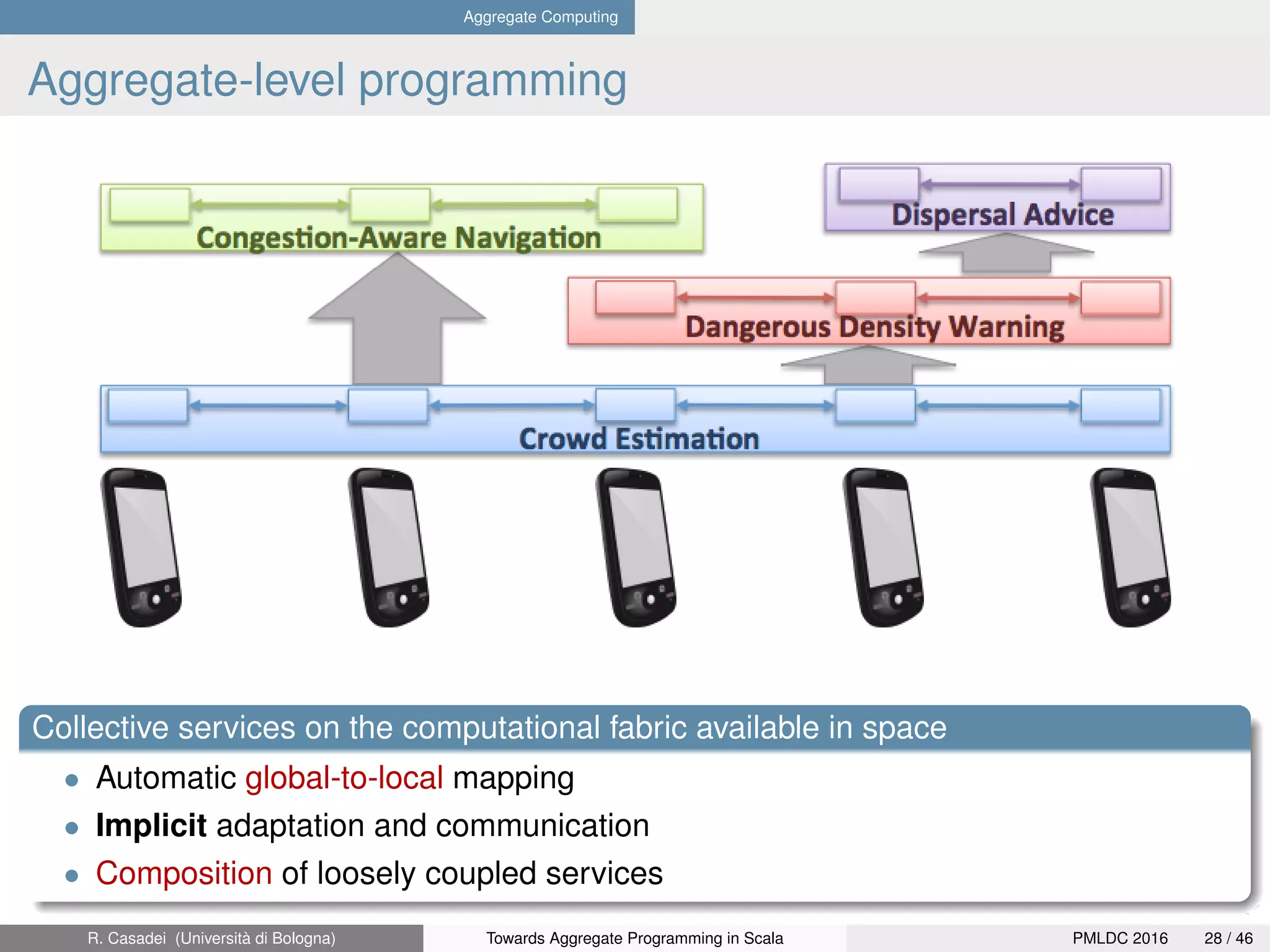
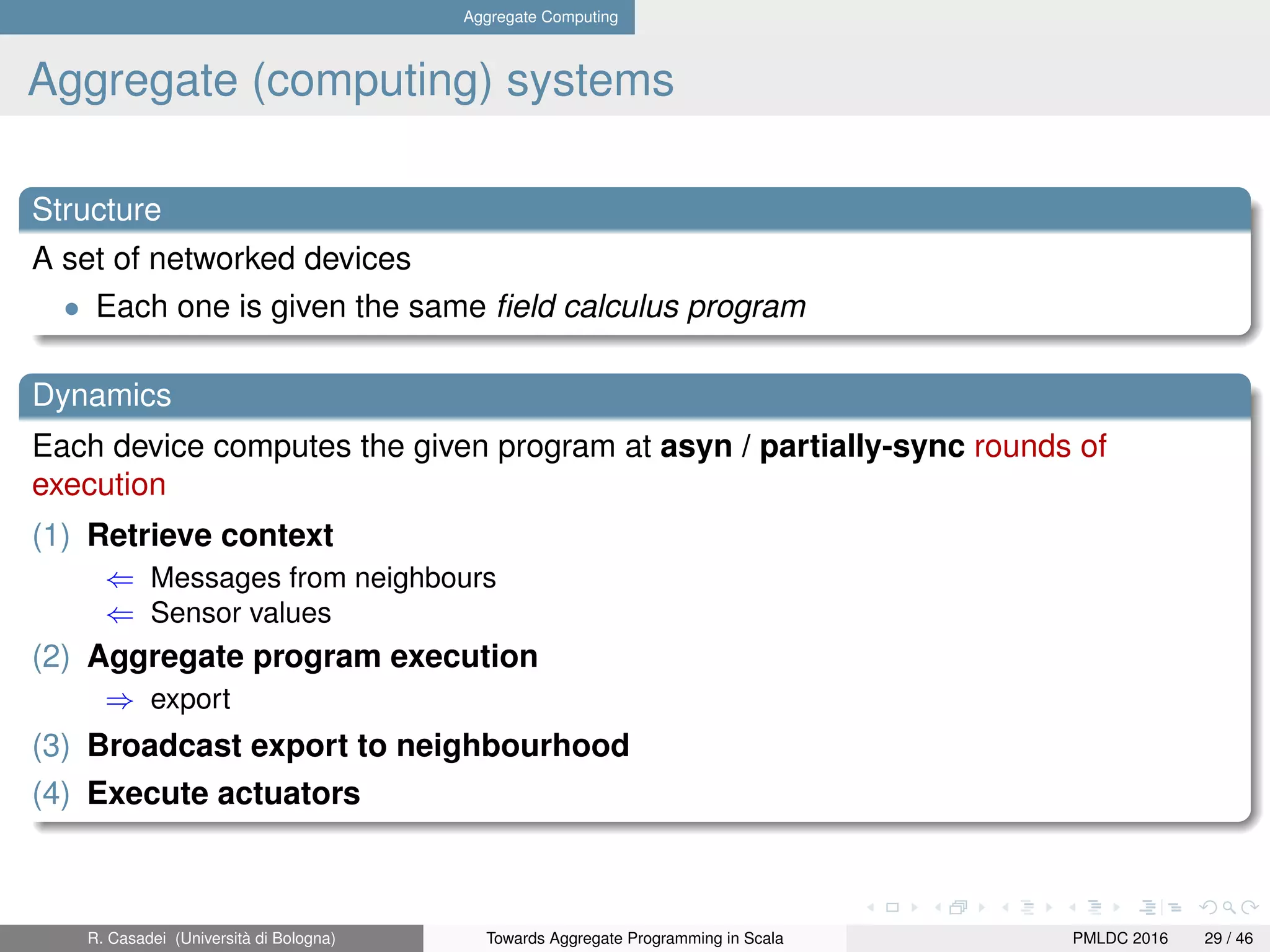
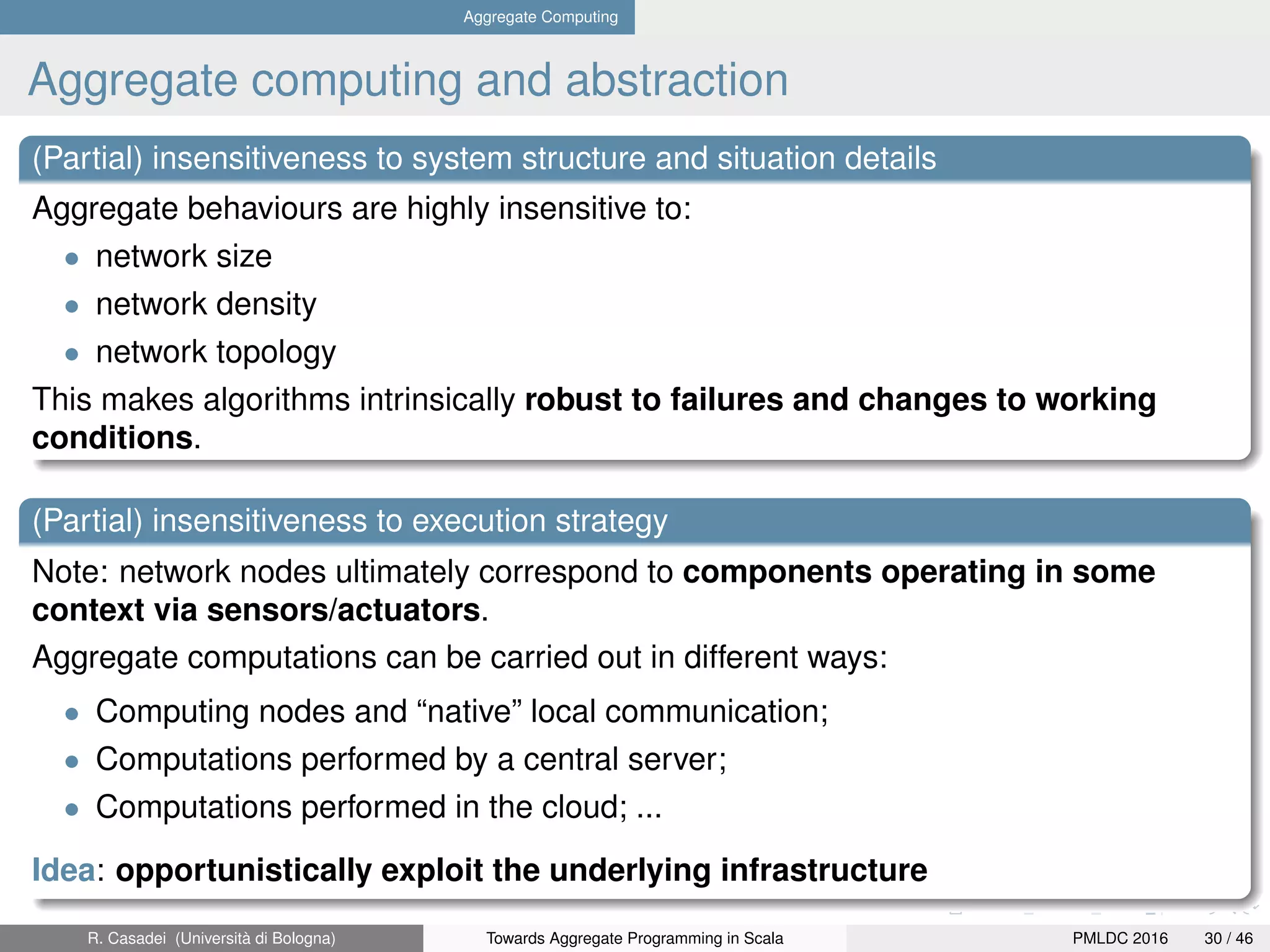
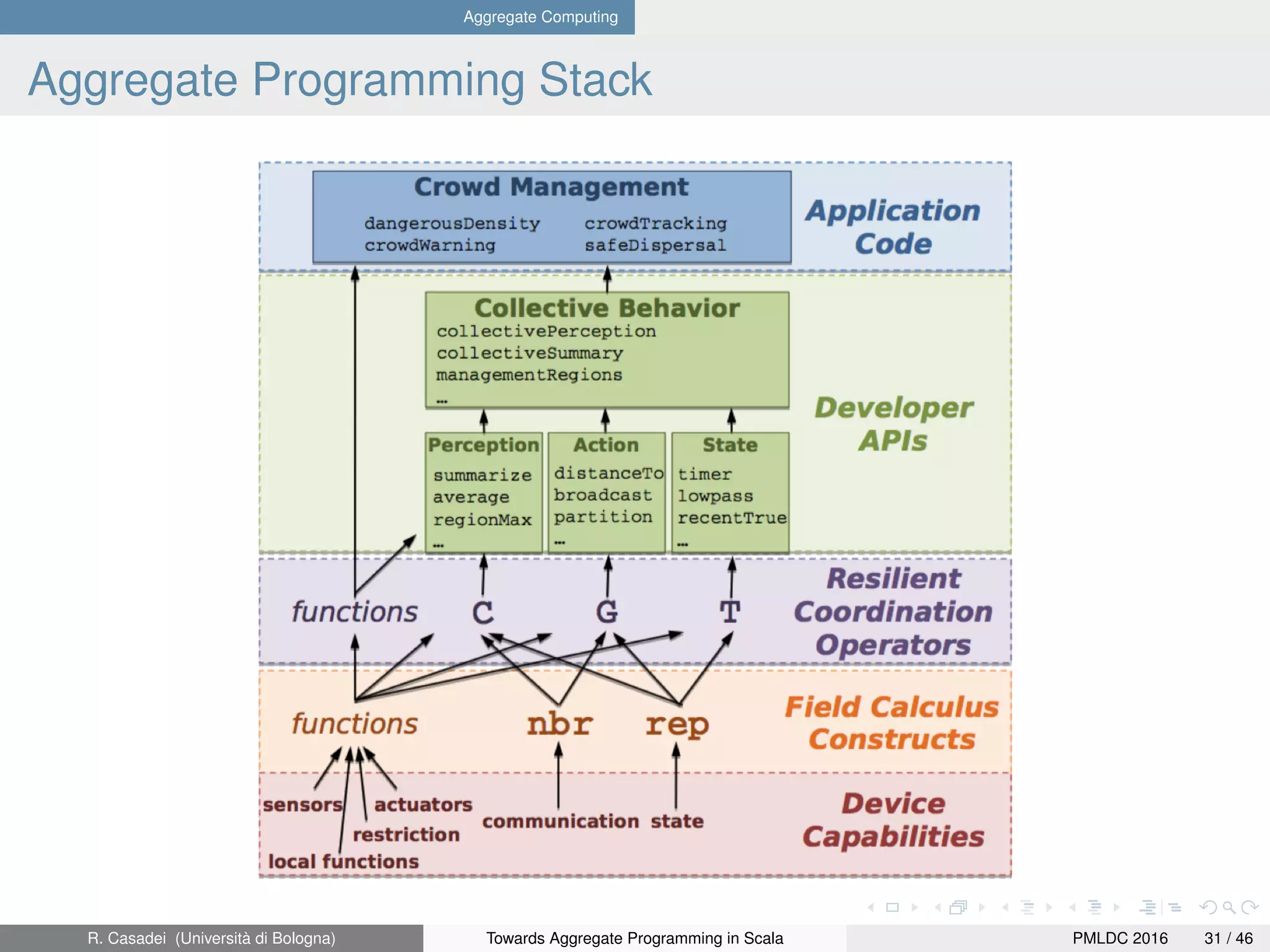
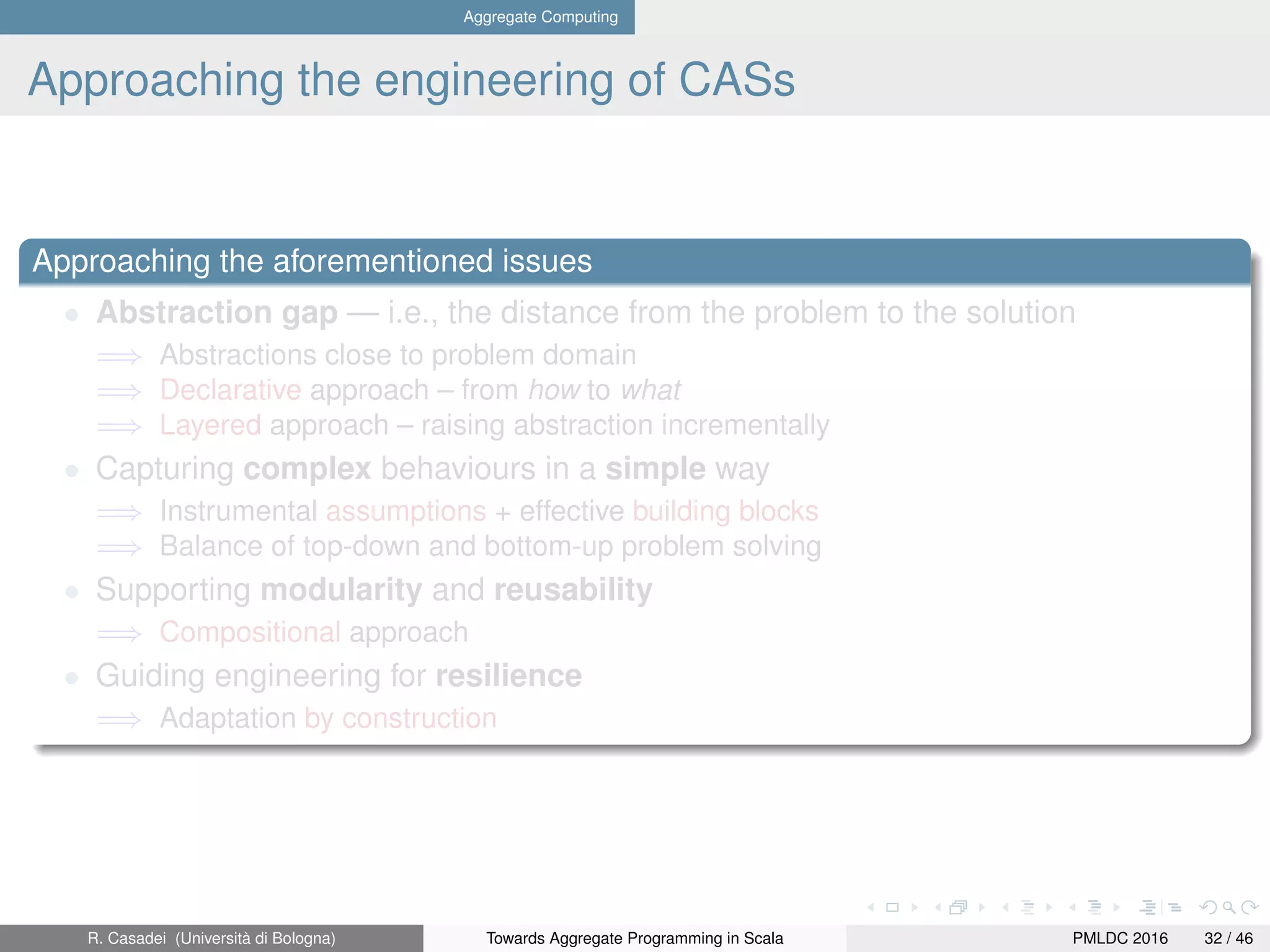
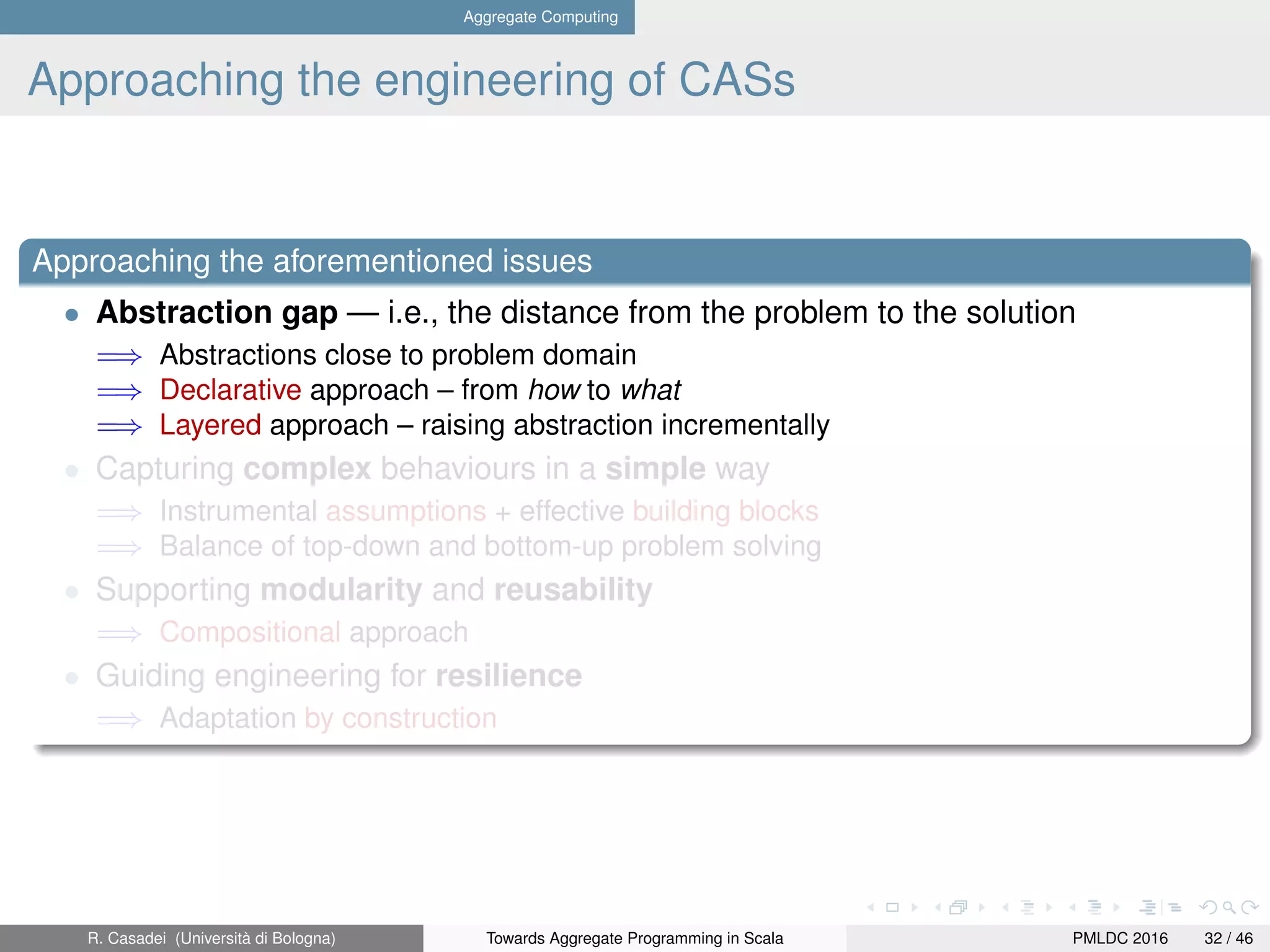
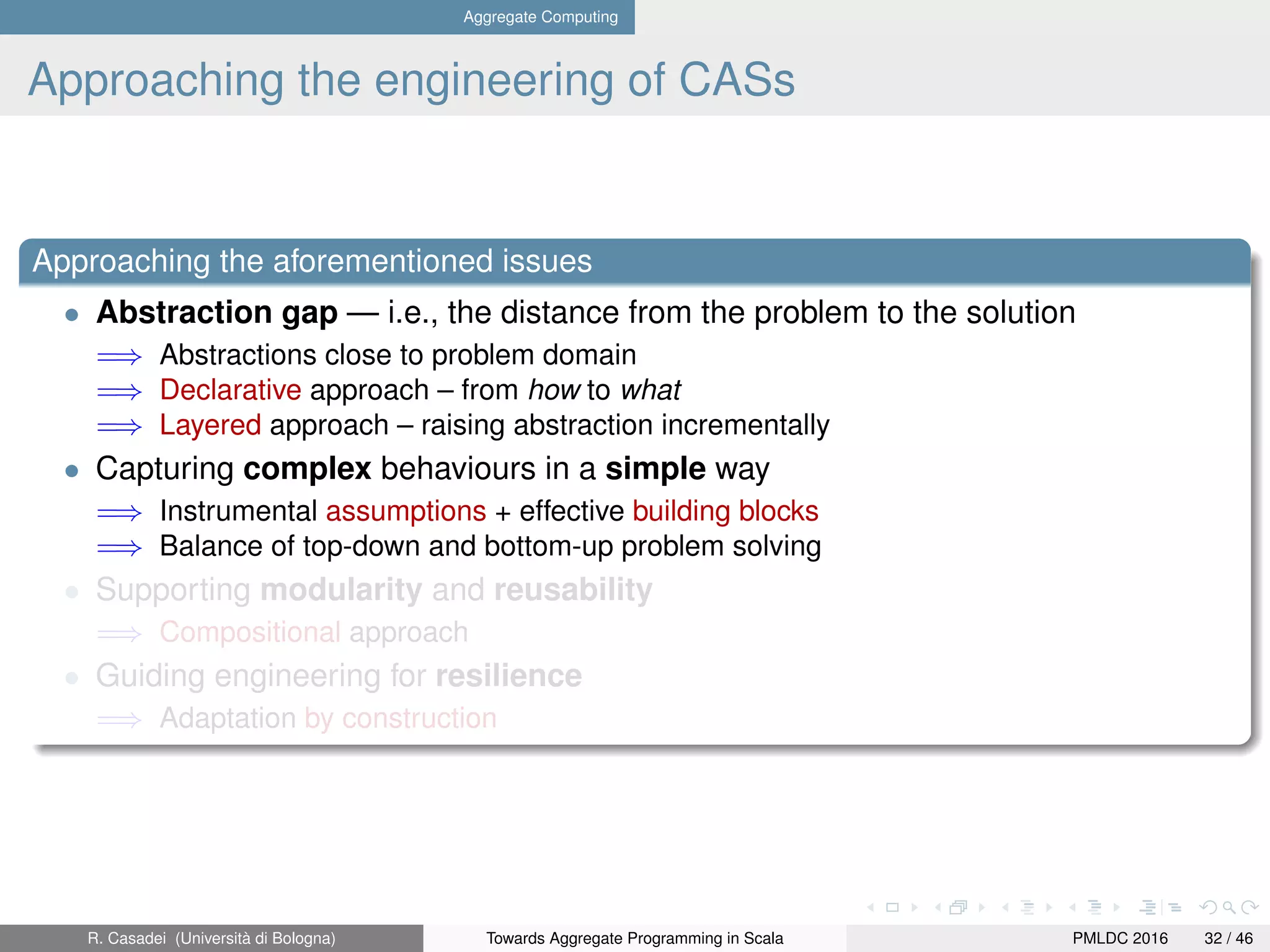
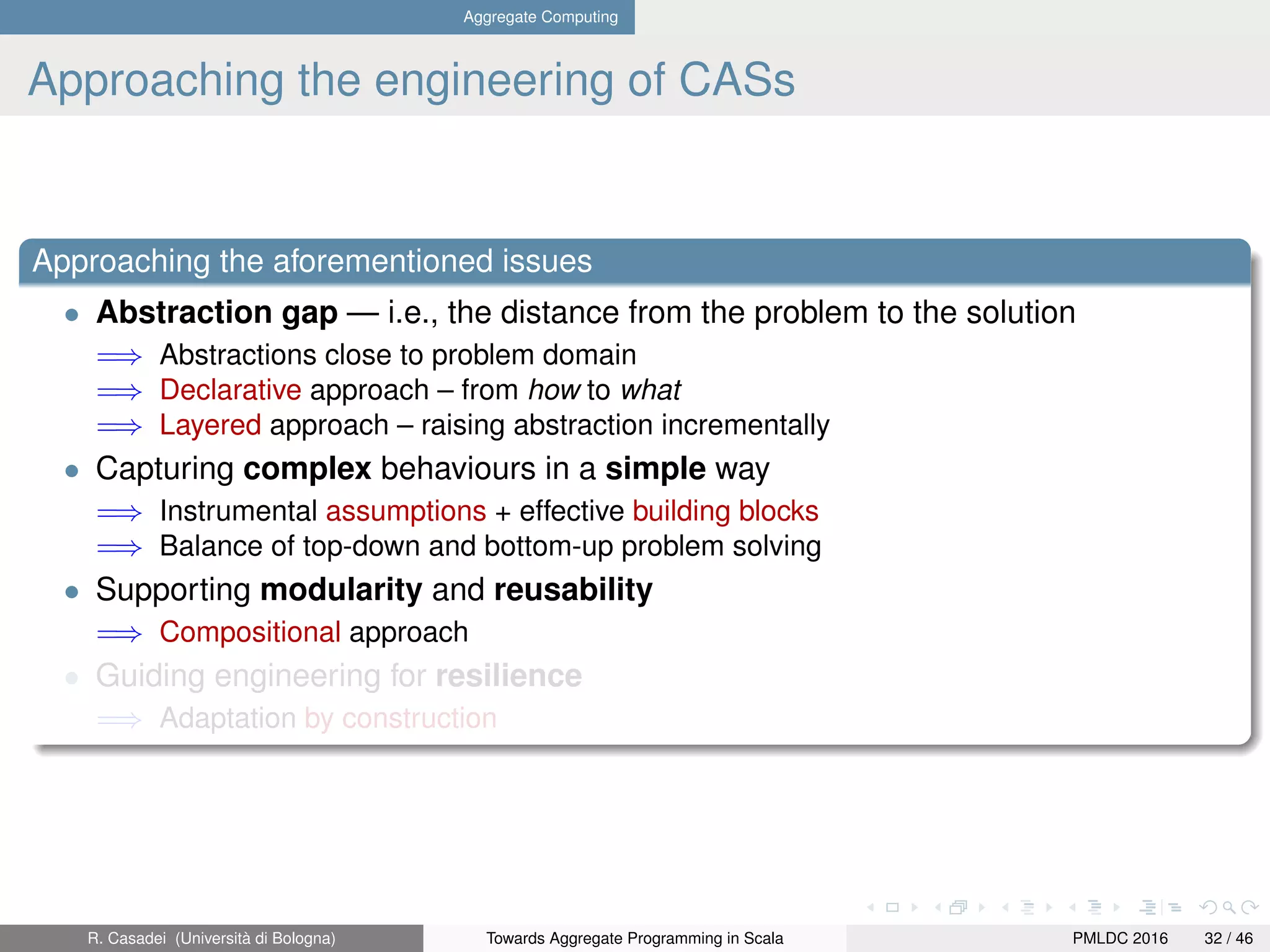
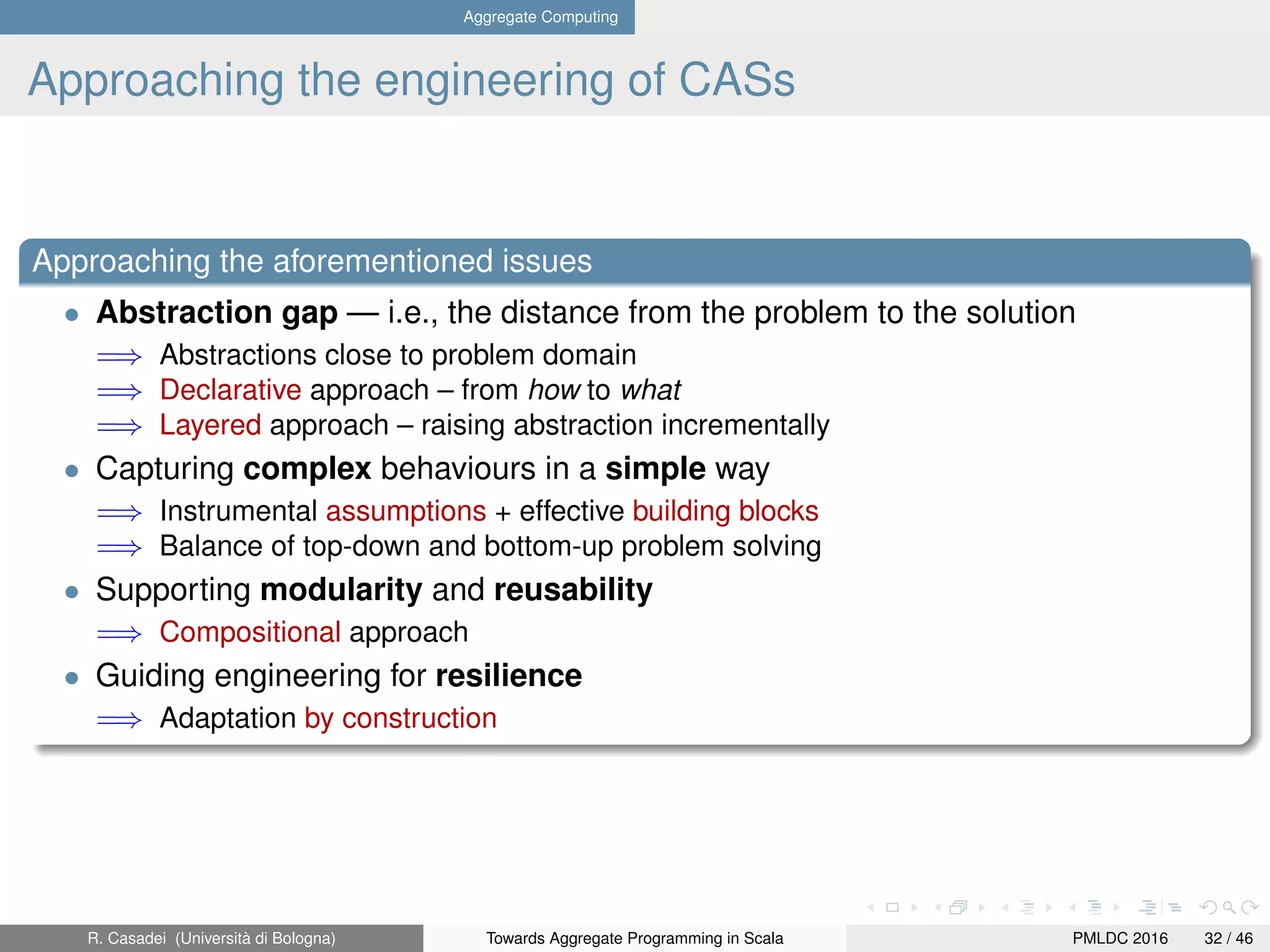
![Aggregate Computing Aggregate Programming Toolchain Up to a few months ago.. Protelis [PVB15] + Alchemist simulator [PMV13] • External DSL • Focus on simulation Technological gap: there is no aggregate programming framework, aimed at the construction of real-world applications, integrated in a ≈mainstream language ⇒ SCAFI (scala with computational fields) • Scala-internal DSL for expressing aggregate computations • Distributed platform for execution of aggregate systems SCAFI: where? http://scafi.apice.unibo.it • A more serious release soon :) R. Casadei (Università di Bologna) Towards Aggregate Programming in Scala PMLDC 2016 33 / 46](https://image.slidesharecdn.com/presentation-161022140524/75/Towards-Aggregate-Programming-in-Scala-41-2048.jpg)
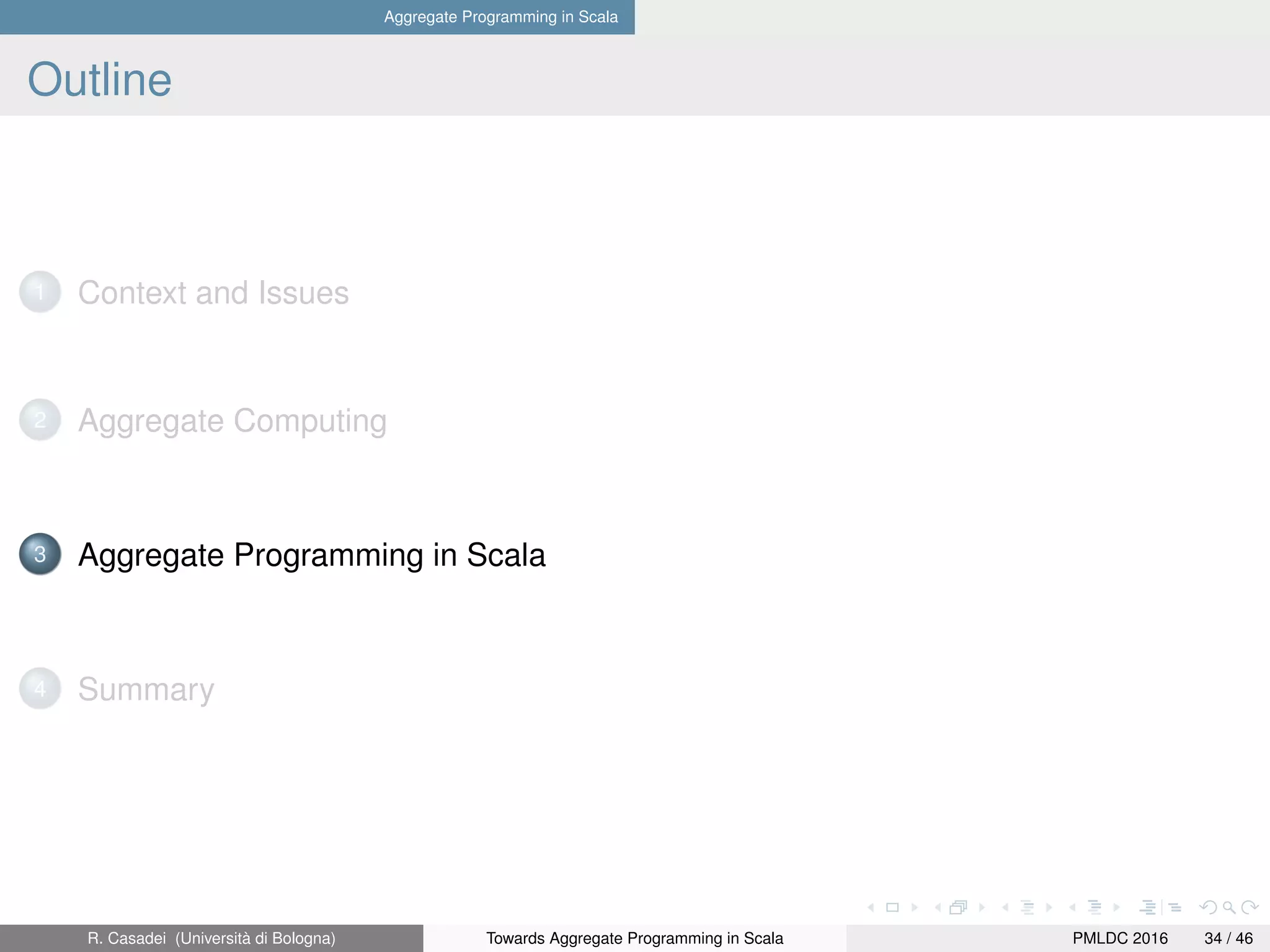
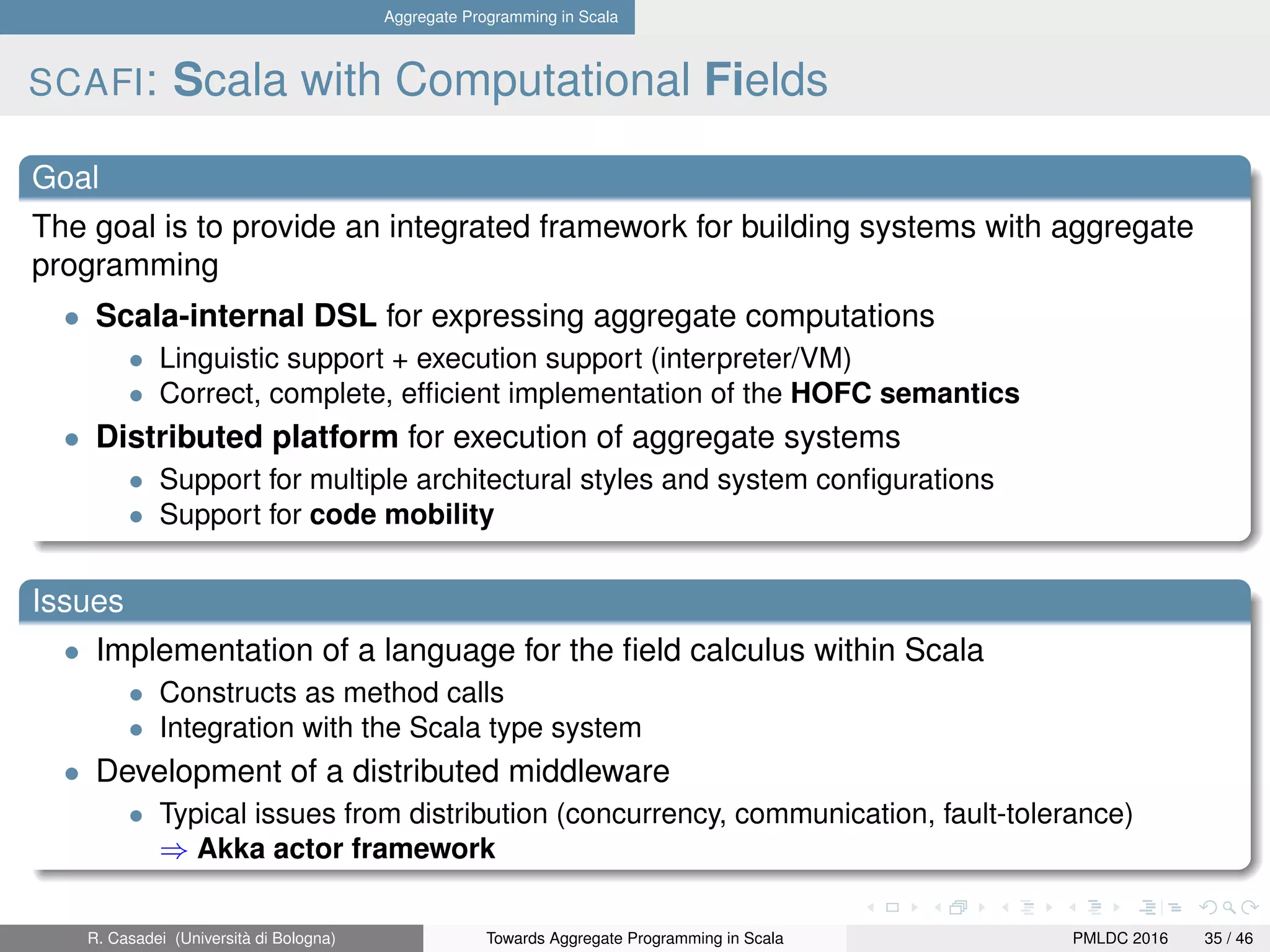
 (fun: (A) => A): A def nbr[A](expr: => A): A def foldhood[A](init: => A) (acc: (A,A)=>A) (expr: => A): A def branch[A](cond: => Boolean) (th: => A) (el: => A): A def aggregate[A](f: => A): A def sense[A](name: LSNS): A def nbrvar[A](name: NSNS): A } Where are computational fields? R. Casadei (Università di Bologna) Towards Aggregate Programming in Scala PMLDC 2016 36 / 46](https://image.slidesharecdn.com/presentation-161022140524/75/Towards-Aggregate-Programming-in-Scala-44-2048.jpg)
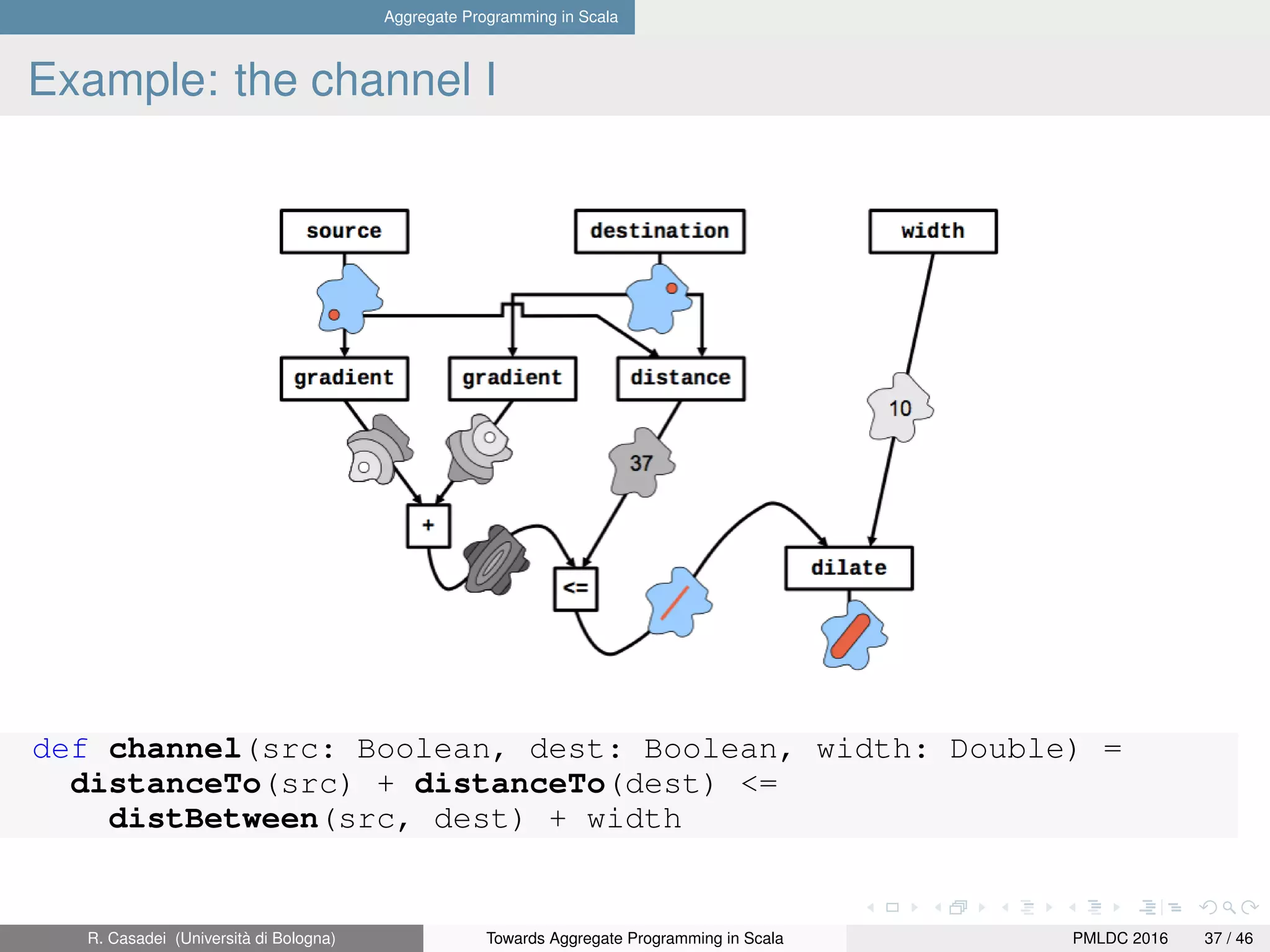
 def G[V:OB](src: Boolean, field: V, acc: V=>V, metric: =>Double): V = rep( (Double.MaxValue, field) ){ dv => mux(src) { (0.0, field) } { minHoodMinus { val (d, v) = nbr { (dv._1, dv._2) } (d + metric, acc(v)) } } }._2 def broadcast[V:OB](source: Boolean, field: V): V = G[V](source, field, x=>x, nbrRange()) def distanceTo(source: Boolean): Double = G[Double](source, 0, _ + nbrRange(), nbrRange()) def distBetween(source: Boolean, target: Boolean): Double = broadcast(source, distanceTo(target)) def isSource = sense[Boolean]("source") def isObstacle = sense[Boolean]("obstacle") R. Casadei (Università di Bologna) Towards Aggregate Programming in Scala PMLDC 2016 38 / 46](https://image.slidesharecdn.com/presentation-161022140524/75/Towards-Aggregate-Programming-in-Scala-46-2048.jpg)
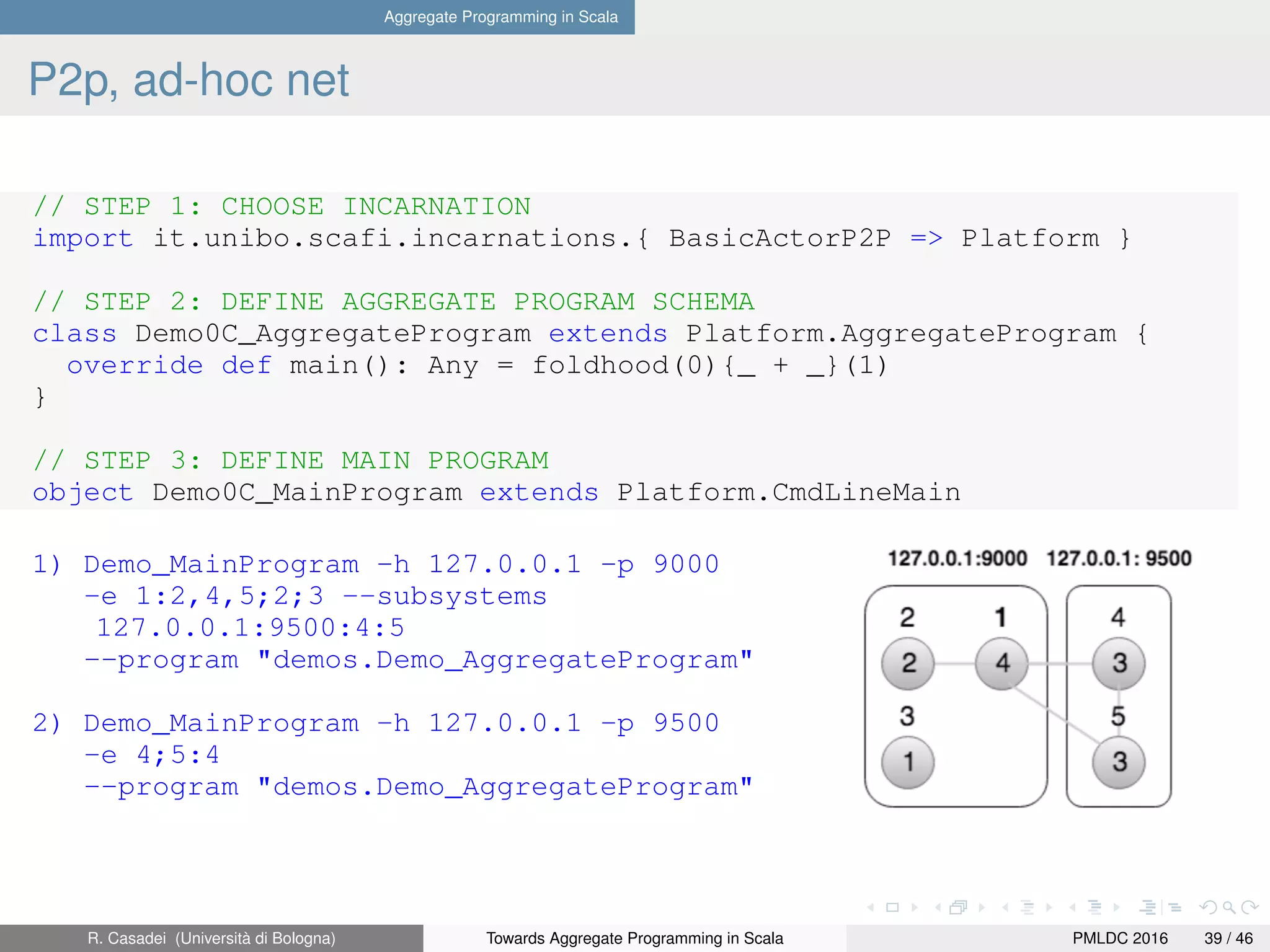
]): SPACE[E] = new Basic3DSpace(elems.toMap) { override val proximityThreshold = 1.1 } } // STEP 2: DEFINE AGGREGATE PROGRAM SCHEMA class Demo3_AggregateProgram extends Demo3_Platform.AggregateProgram { def hopGradient(source: Boolean): Double = { rep(Double.PositiveInfinity){ hops => { mux(source) { 0.0 } { 1+minHood(nbr{ hops }) } } } } def main() = hopGradient(sense("source")) } R. Casadei (Università di Bologna) Towards Aggregate Programming in Scala PMLDC 2016 40 / 46](https://image.slidesharecdn.com/presentation-161022140524/75/Towards-Aggregate-Programming-in-Scala-48-2048.jpg)
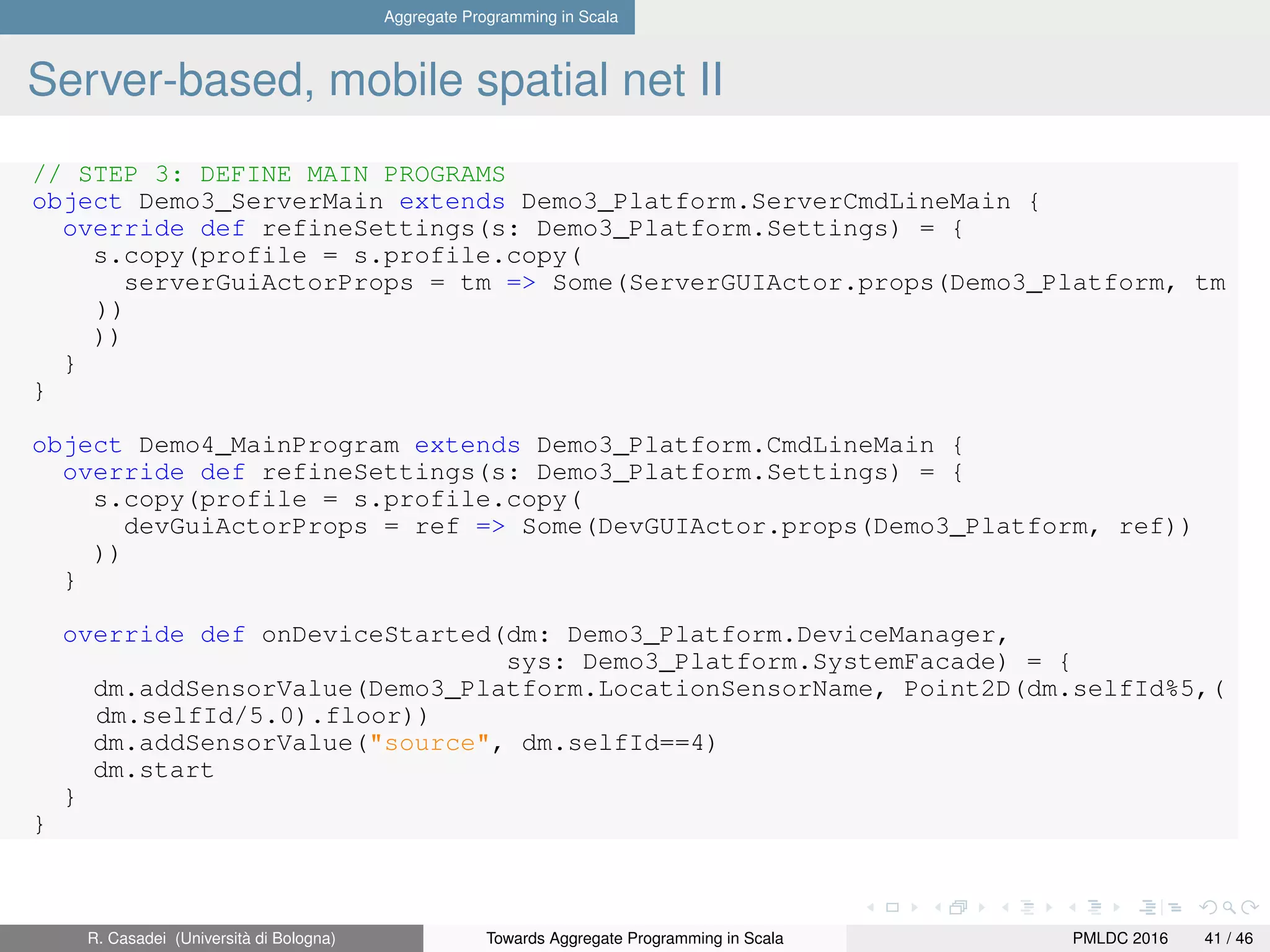
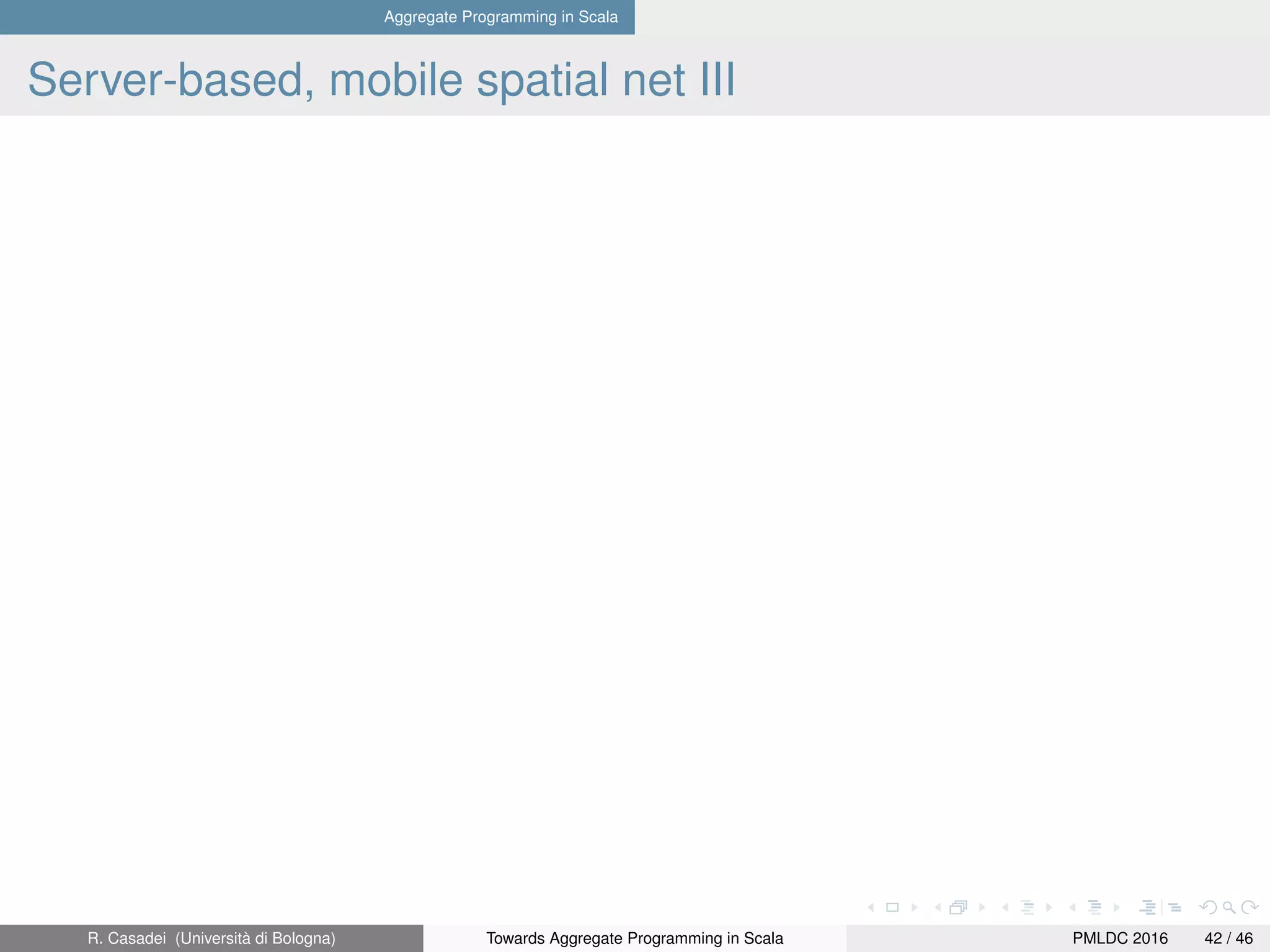
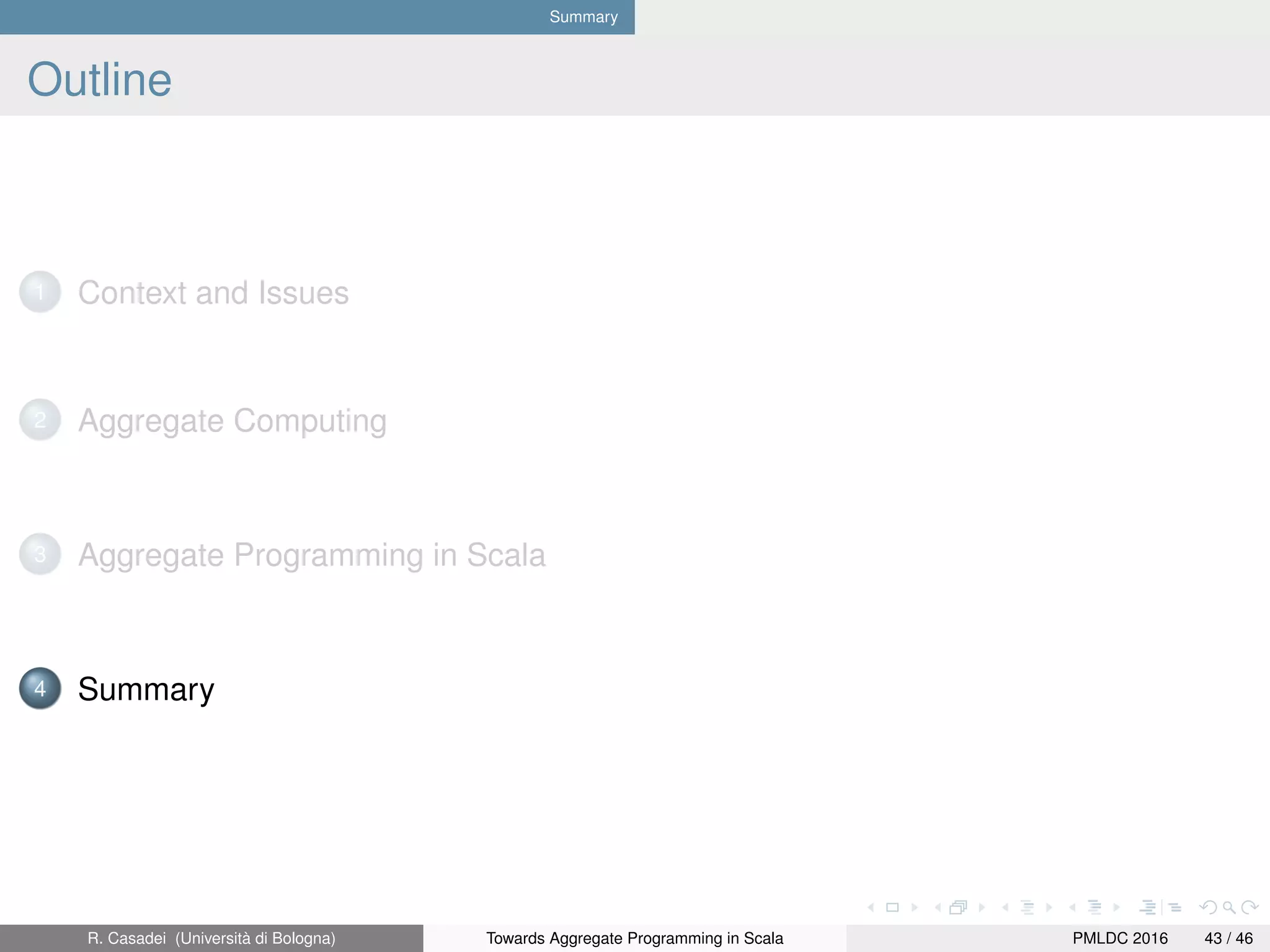
![Summary Summary: key ideas and future directions Aggregate programming • An ((((((( programmingengineering approach to CASs • Formally grounded in the Field Calculus • Allows to compose “emergent” phenomena • Provides layers of building blocks (proven to self-stabilise!) A Scala framework for aggregate programming is out! • Supports the construction of aggregate systems • Integrated in Scala No need to learn ad-hoc external DSLs Easier to get started and play • Better release (e.g., to Maven Central) soon, I promise :) Many open problems [VB] (want to join?) • Space-time universality • Fields vs. objects/agents/processes/worflows • Better resilience properties than self-stabilisation • Adapting the execution strategy to available infrastructure (e.g., cloud, fog, ...) R. Casadei (Università di Bologna) Towards Aggregate Programming in Scala PMLDC 2016 44 / 46](https://image.slidesharecdn.com/presentation-161022140524/75/Towards-Aggregate-Programming-in-Scala-52-2048.jpg)
![Appendix References References I [BPV15] Jacob Beal, Danilo Pianini, and Mirko Viroli. Aggregate Programming for the Internet of Things. IEEE Computer, 2015. [BV15] Jacob Beal and Mirko Viroli. Space–time programming. Phil. Trans. R. Soc. A, 373(2046):20140220, 2015. [Duc13] Matt Duckham. Decentralized Spatial Computing - Foundations of Geosensor Networks. Springer, 2013. [DVB16] Ferruccio Damiani, Mirko Viroli, and Jacob Beal. A type-sound calculus of computational fields. Science of Computer Programming, 117:17 – 44, 2016. [DVPB15] Ferruccio Damiani, Mirko Viroli, Danilo Pianini, and Jacob Beal. Code mobility meets self-organisation: A higher-order calculus of computational fields. volume 9039 of Lecture Notes in Computer Science, pages 113–128. Springer International Publishing, 2015. R. Casadei (Università di Bologna) Towards Aggregate Programming in Scala PMLDC 2016 45 / 46](https://image.slidesharecdn.com/presentation-161022140524/75/Towards-Aggregate-Programming-in-Scala-53-2048.jpg)
![Appendix References References II [FMSM+ 13] Jose Luis Fernandez-Marquez, Giovanna Di Marzo Serugendo, Sara Montagna, Mirko Viroli, and Josep Lluís Arcos. Description and composition of bio-inspired design patterns: a complete overview. Natural Computing, 12(1):43–67, 2013. [PMV13] Danilo Pianini, Sara Montagna, and Mirko Viroli. Chemical-oriented simulation of computational systems with alchemist. Journal of Simulation, 7(3):202–215, 2013. [PVB15] Danilo Pianini, Mirko Viroli, and Jacob Beal. Protelis: practical aggregate programming. In Proceedings of the 30th Annual ACM Symposium on Applied Computing, pages 1846–1853. ACM, 2015. [VB] Mirko Viroli and Jacob Beal. Resiliency with Aggregate Computing : State of the Art and Roadmap. R. Casadei (Università di Bologna) Towards Aggregate Programming in Scala PMLDC 2016 46 / 46](https://image.slidesharecdn.com/presentation-161022140524/75/Towards-Aggregate-Programming-in-Scala-54-2048.jpg)